#6 April 1886
Text






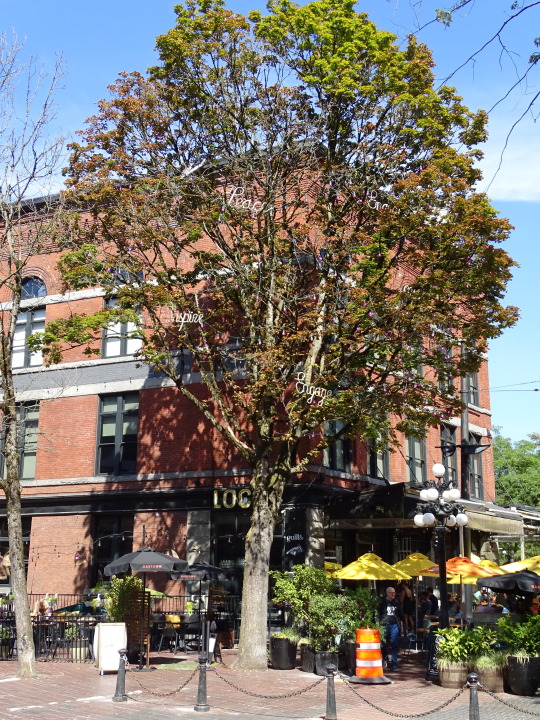






















Vancouver was incorporated on April 6, 1886.
#Marine Building#Canada Place#Gastown Steam Clock#Granville Island#Burrard Bridge#Vancouver Public Library#Robson Square#Stanley Park#Vancouver#incorporated#6 April 1886#anniversary#Canadian history#travel#summer 2023#tourist attraction#landmark#architecture#British Columbia#Canada#flora#original photography#vacation#cityscape#2012#Pacific Ocean#Inukshuk by Alvin Kanak#Davie Village#Sunset Beach#Digital Orca by Douglas Coupland
4 notes
·
View notes
Photo

Te Wharetoroa Tiniraupeka (1863-1964) - Kahu waero (dog hair tassel cloak),1890s-1900. Muka (New Zealand flax fibre), awe (dog hair tassles), natural dye.
This kahu waro was woven by Te Wharetoroa Tiniraupeka (Ngāti Tunohopu, Ngāti Whakaue, Te Arawa).
Te Wharetoroa was born in August 1863 at Tarawera, Rotorua region. She was a survivor of the Tarawera eruption 10 June 1886 (see Neich “Carved Histories” 2001:34). Te Wharetoroa was recorded by her grandneice Mrs Hilda Inia, to have lived her adult life between Ohinemutu, Waikuta and Wainui, Whakatane. She died in 1964 aged 101, and is buried at Wainui, Whakatane. Te Wharetoroa was a strong minded business woman and devout follower of the Ringatu faith. She was recorded to have known Te Kooti personally (Neich 2001:34). Te Wharetoroa had a meeting house built called “Tiki”, at Ohinemutu for Ringatu services, which was carved by Tene Waitere in 1913.
It is not known when Te Wharetoroa wove the cloak, but she was known to have had a collection of taonga and operated a “curio shop”. She wove and also carved small items according to Hilda Inia. The cloak was dyed at Waikuta where she had her home named “Te Kurī”. The cloak was stolen from her home c1909 and was later discovered on display in the Dominion Museum by Te Wharetoroa and George Graham (her partner at the time) in 1921. Te Wharetoroa writes to the Acting Director, J.W McDonald on the 30 October, 1921 to identify herself as the weaver and the fact that it was stolen some 12 years before with other taonga. The cloak was in keeping as a memory of her mother. George Graham also wrote letters in support of Te Wharetoroa. Eventually it was returned after correspondence over a period of 6 months. The cloak was sent to George Graham in Auckland. It was later deposited in the Auckland Museum under the Hori Montrose Graham Collection between 1927-30. It is not known what happened between Te Wharetoroa and Graham, but the collection was signed out by his written authority between 1941 and 1946 through his daughter Mrs Beatrice Mika and grand-daughter Miss Josephine Mika. Some items were exchanged as well. The cloak was withdrawn from the Auckland Museum on the 17th September, 1946. The cloak was never returned to Te Wharetoroa, dispite her lawyers making inquiries at the Auckland Museum in 1952. George Graham died on 11 April 1952. The cloak was sold to the Wellington jeweller Miet at some point, then sold by Dunbar Sloane Auction to the National Museum, 19th September, 1991.
The body of the cloak is weft twined in double pair twining with regularly spaced dog-hair tassels. It has been dyed using the traditional paru method, after weaving. This can be clearly observed under tassel number 5, proper right of row 2. The tassels of dog-hair are created by shaving the hair from the tail. Bundles of hair were then bound with fine undyed muka in a series of buttonhole stitches used to create the head of the tassel. Tassels were then stitched to the kaupapa of the cloak with undyed muka. The lower edge is left unworked, indicating that a probable taniko border has been cut off.
Neich, Roger, “Carved Histories:Rotorua Ngāti Tarawhai Woodcarving”, 2001, published by Auckland University Press; Auckland.
3 notes
·
View notes
Text
Amos Fuller - Earning a Living
Amos Fuller is my 2nd great-grandfather (Ahnentafel #26). He was born in Alabama between 1847 and 1850 of Alabama parentage.
The earliest record found for Amos Fuller is the 1870 U. S. Census. He is listed as “Ames” Fuller, a twenty-three year old black male, born in Alabama. His occupation is given as “St.Bt.L???.[1] This abbreviation at first glance is rather cryptic. Ancestry transcribed the occupation as “St Bt Land”. Additional research on Amos’ occupations suggest that “St. Bt.” stands for steam boat.
I was able to trace Amos consistently through the Mobile City directories. He first appears in the directory in 1877 with the occupation of “laborer”. Amos is also classified as a laborer in the 1879 and 1880 directories. [2] The 1880 U. S. Census gives Amos Fuller’s occupation as stevedore. This is a dock worker who loads and unloads ships in port.[3]
In the 1884 Mobile City directory, Amos Fuller is listed as a steamboat hand.[4] This means that he was employed by a steamboat as part of the crew. Deckhands made up the bulk of the crew. Most of the deckhands were immigrants and freedmen. Their job was to load and unload cargo transported on the steamboat. Deckhands worked almost 24/7, bunked with the cargo and were paid low wages.[5]
Amos Fuller had a change of occupation as noted in the 1885-1886 and 1887 Mobile City directories. He is listed as “fireman Mobile ice Factory.”[6] Contrary to our popular image of a fireman, Amos was not putting out fires, he was stoking up fires. A fireman’s job was to shovel coal or wood into a boiler to keep it running.[7] Ice factories of the late 1880s used steam engine powered pumps which were integral in the process of making ice.[8]
For the next several years, Amos Fuller was listed in the Mobile City directories as a laborer.
In the 1894 Mobile City directory Amos was listed with the occupation of “fireman stbt D. L. Tally.”[9] Steamboat firemen reported to the engineer. The fireman’s job was to stoke the boiler to keep the steam engine running. They shoveled coal all day, hour after hour. Not only was this a strenuous job, it was also dangerous. If a boiler exploded the fireman would be the first to die. [10]
The steamer D. L. Tally was a packet boat based in Mobile, Alabama. It traveled the Alabama River carrying freight, mail and passengers.

“The Steamer D. L. Tally,” The Monroe Journal (Claiborne, Alabama), 18 October 1894, p. 2, col. 4, Newspapers.com (https://www.newspapers.com/image/244603449 : accessed 7 February 2024).
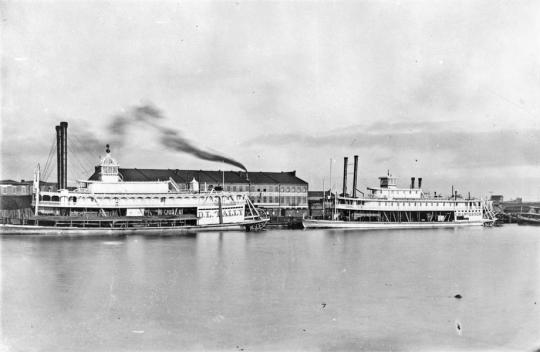
Image: Left to Right: D. L. Tally; sternwheel C. W. Anderson, n.d., black and white photographic print. From the Collection, UW-La Crosse Historic Steamboat Photographs. Used with written permission of Murphy Library Special Collections / ARC, University of Wisconsin-La Crosse.

Image: D. L. Tally (Packet, 1870-1895), n.d., black and white photographic print. From the Collection, UW-La Crosse Historic Steamboat Photographs. Used with written permission of Murphy Library Special Collections / ARC, University of Wisconsin-La Crosse.
In the 1900 Mobile City Directory, Amos had the following listing: “Fuller Amos, c, stbtmn, res 252 Lipscomb.”[11] This was the last time his occupation was specified as a steamboat man.
Amos Fuller died on 4 September 1909 of pulmonary tuberculosis.[12] One wonders if his exposure to coal dust had any relationship to the tuberculosis.
Sources
1870 U.S. census, Mobile County, Alabama, population schedule, Mobile Ward 8, p. 36, dwelling 257, family 257, Ames Fuller; digital images, FamilySearch (https://www.familysearch.org/ark:/61903/3:1:S3HT-6FZ9-M5B : accessed 17 April 2021); microfilm 545530/digital 4257608 > image 673 of 818; citing National Archives and Records Administration microfilm M593, roll 31.
Henry Farrow & Co's Mobile City Directory For the Year 1877, (Mobile: Henry Farrow & Co., 1876), 76, entry for "Fuller Amos"; also subsequent years with varying titles, specifically (1878) 68 and (1880) 69; imaged in “U.S., City Directories,” Ancestry (https://www.ancestry.com : accessed 15 September 2017).
1880 U.S. census, Mobile County, Alabama, population schedule, Mobile, enumeration district (ED) 140, p. 21 (written), 367A (stamped), dwelling 189, family 190, Amos Fuller household; digital images, FamilySearch (https://www.familysearch.org/ark:/61903/3:1:33SQ-GYYL-HRT : accessed 13 September 2017) microfilm 1254025 / digital 5157243 > image 459 of 791; citing National Archives and Records Administration microfilm T9, roll 25.
George Matzenger’s Mobile Directory For The Year 1884, Volume XX (Mobile: George Matzenger, 1884), 104, entry for ”Fuller Amos”; imaged in “U.S., City Directories, 1822-1995,” Ancestry (https://www.ancestry.com : accessed 6 February 2024) > Alabama > Mobile > 1884 > Mobile, Alabama, City Directory, 1884 > image 55 of 215.
“Steamboat Heroine: The Crew of a Western Steamboat,” Oklahoma Historical Society (https://www.okhistory.org/learn/steamboat4 : accessed 7 February 2024).
George Matzenger’s Mobile Directory For 1885-6 (Mobile: George Matzenger, 1885), 100, entry for “Fuller Amos”; also the subsequent year (1887) 113; imaged in “U.S., City Directories,” Ancestry (https://www.ancestry.com : accessed 15 September 2017).
Wikipedia contributors, "Fireman (steam engine)," Wikipedia, The Free Encyclopedia (https://en.wikipedia.org/w/index.php?title=Fireman_(steam_engine)&oldid=1187171257 : accessed February 4, 2024).
"When Steam Brought Cold, and Fire Made Ice," blog post, Hometown by Handlebar, posted 14 July 2022 (https://hometownbyhandlebar.com : accessed 4 February 2024).
George Matzenger’s Mobile Directory For 1894, Volume XXIX (Mobile: George Matzenger, 1894), 122, entry for “Fuller Amos”; imaged in "U.S., City Directories, 1822-1995," Ancestry (https://www.ancestry.com : accessed 6 February 2024) > Alabama > Mobile > 1894 > Mobile, Alabama, City Directory, 1894 > image 72 of 273.
“Steamboat Heroine: The Crew of a Western Steamboat.”
George Matzenger’s Mobile Directory For 1900, Volume XXXV (Mobile: George Matzenger, 1900), 149, entry for “Fuller Amos”; imaged in "U.S., City Directories, 1822-1995," Ancestry (https://www.ancestry.com : accessed 6 February 2024) > Alabama > Mobile > 1900 >Mobile, Alabama, City Directory, 1900 > image 80 of 322.
Alabama Department of Health, death certificate no. 147 (1909), Amos Fuller, d. 4 September 1909, Mobile; digital image, "Alabama Deaths, 1908-1974," FamilySearch (https://www.familysearch.org : accessed 16 August 2022). This image is only viewable at a family history center or affiliate library.
2 notes
·
View notes
Text

Ed Wynn (November 9, 1886 - June 19, 1966) with Lucille Ball (August 6, 1911 - April 26, 1989),
4 notes
·
View notes
Text
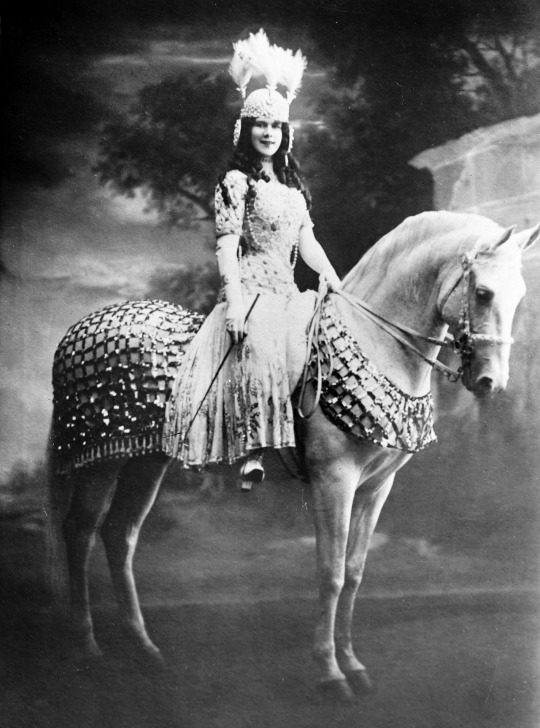
Baptista Mijares-Schreiber was a circus artiste, horsewoman and circus director.
Baptista Mijares-Schreiber was born on 6 April 1886 in Stockholm, the daughter of Bertha Lindberg and Johan Baptist Schreiber. Her father was a circus artist and rider and a circus director from an Austrian family but born in Belgium. Her mother was an actress from Stockholm. Her father died at the early age of 33 years old, of pneumonia. Her mother continued with the children to live a circus life. When Baptista Mijares-Schreiber was five years old, she made her debut as a tightrope dancer and just before the turn of the century 1900, her mother revived the family circus with her new life companion. Baptista Mijares-Schreiber and her brother Jean Schreiber became the main attractions in various riding numbers.
In 1909, Baptista Mijares-Schreiber left her mother’s circus company to be a jockey rider with Circus Albert Schumann in Berlin. She stayed there for a year or so and was among other things an expert at various leaps up from the ring onto the horses’ backs, but she injured herself during a guest appearance in Vienna and was no longer able to carry on with that type of number. She trained anew as a school rider and purchased a school horse with which to start performing. In 1912, Baptista Mijares-Schreiber was working for the Circus Ciniselli in Köpenhamn. There she met the Danish tenor and actor Otto Detlefssen, who was to be her first husband. In 1913, Baptista Mijares-Schreiber’s horse was poisoned and died under mysterious circumstances. Lord Lonsdale, who had been at the circus when the horse died and who was the widowed queen Alexandra’s confidant, decided with the queen to organise a gala performance in aid of a new horse for Baptista Mijares-Schreiber. The time around the first world war demonstrated Baptista Mijares-Schreiber’s broad competence – she worked as a school rider, actress, cabaret singer and operetta prima donna in Denmark and Sweden. In certain of her numbers, her husband also participated as a singing cowboy.
At the beginning of the 1920s, Baptista Mijares-Schreiber’s international career accelerated and she had a longer engagement in Paris. From 1922 onwards she was working in London together with the Mexican brothers Jesús (Chuy) and Manuel Mijares who were tightrope dancers. Their first shared appearance in Sweden took place at Circus Schumann in Stockholm in the spring of 1924. Baptista Mijares-Schreiber divorced her first husband in 1925 and married Chuy Mijares two years later. Together they started Circus Mijares-Schreiber that was active in Sweden. The couple chose Karlskoga as the place to put up a permanent circus all year round. Baptista Mijares-Schreiber purchased the so-called Doctor’s Villa from Karlskoga municipality and a preliminary contract of sale was made up. Her plans met with opposition from the inhabitants however, and indignant gentlemen persuaded the municipal council to reject Baptista Mijares-Schreiber’s request to purchase. Baptista Mijares-Schreiber then purchased a different plot instead in 1932 and had a circus building put up for winter stationing in Karlskoga. She also had a house built for herself and her husband next door to the circus.
One of the climaxes of the performance was the Mijares brothers’ tightrope dance number, and the circus expanded. In 1933, Baptista Mijares-Schreiber’s husband Chuy Mijares started to spend more time on administration, but the couple still drove their horses in the ring. At the end of the 1940s, the modest tent circus had expanded into a gigantic circus with several rings. However, in 1950 the one-ring circus was reinstated. In 1955, the circus took place for the last time. Baptista Mijares-Schreiber was skillful at enthralling her audience every time she rode, drove her horses or gave a speech in the ring. She was a master of getting her audience in Sweden to believe that their town in particular was close to her heart. Baptista Mijares-Schreiber was a great company director, and she knew just how to create publicity about her enterprise.
Baptista Mijares-Schreiber was also a convinced friend of animals who never tolerated the slightest neglect when it came to her horses or dogs. This was demonstrated for example by the fact that she applied to bury her beloved horse Menelik in the churchyard in Karlskoga. She was denied this and Menelik was buried instead outside the church wall at the forest cemetery at Rävåskullen in Karlskoga. This place is still today marked and the so-called horse grave is advertised by the municipality as an attraction. The memory of the circus and of Baptista Mijares-Schreiber and her deeds also continues to survive in the form of the so-called horse roundabout, close to where her circus once was situated – a roundabout on which a local artist has erected a statue of three bucking horses on their hind legs.
Shortly after the final performance of the season in 1955, Chuy Mijares died and Baptista Mijares-Schreiber lost her motivation to continue with the circus. Competition was great and running a circus was expensive. The year after, in 1956, Baptista Mijares-Schreiber died at 70 years of age. She lies buried in the Catholic Cemetery in Stockholm.
Article by Annelie Henriksson
(Translated by Margaret Myers)
0 notes
Text
Holidays 4.6
Holidays
Act of Self Determination Day (Cocos Islands)
Animated Cartoon Day
Army Day (US)
Athletic Trainers and Physical Training and Sports Professionals Day (Kyrgyzstan)
Bohring-Optiz Syndrome Awareness Day
California Poppy Day
Castle Day (Japan)
Chakri Memorial Day (Thailand)
Circe Asteroid Day
Conor McGregor Day (UK)
Declaration of Arbroath Day (Scotland)
Drowsy Driver Awareness Day (California)
Feigenbaum Constant Day
406 Day
International Asexuality Day
International Day of Sport for Development and Peace (UN)
International Recruiters Day
International Search & Rescue Beacon/406 Day
International Whistler’s Day
Jump Over Things Day
King Rama I Memorial and Chakri Day (Thailand)
Knock Your Socks Off Day
Larch Day (French Republic)
Modern Olympics Day
Näfelser Fahrt (Battle of Näfels; Switzerland)
National Charlie Brown’s Insecurities Day
National Employee Benefits Day
National Fisherman Day (Indonesia)
National Gang Day
National Health Day (Kiribati)
National Jay Day
National Library Day
National Pajama Day
National Parker Day
National Robert Day
National Siamese Cat Day
National Student-Athlete Day
National Taylor Day
National Wildlife Week begins [until 4.10]
North Pole Day
Ntaryamira Day (Burgundi)
Patriot’s Victory Day (Ethiopia)
Phocaea Asteroid Day
Plan Your Epitaph Day
Post-It Notes Day
Richard the Lionheart Day
Roberto Clemente Day
Self Determination Day (Australia)
Semana Santa (Argentina)
Sorry Charlie Day (in honor of those who have been rejected and lived through it)
Stigtingsdag (a.k.a. Founders Day or Van Riebeeck’s Day; South Africa)
Tartan Day (Canada, US)
Teflon Day
Think About Spring Cleaning Day
Van Riebeeck Day (Capetown, South Africa)
Waltzing Mathilda Day (Australia)
World Day of Physical Activity
World Table Tennis Day
Yazidi New Year (Iraq)
Food & Drink Celebrations
Brew Year's Eve
Fresh Tomato Day
National Acai Bowl Day
National Caramel Popcorn Day
National Carbonara Day (Italy)
National Consider Drinking More Helles Day
National Food Faces Day
National Twinkie Day
National Viognier Day
New Beer's Eve
St. Sixtus' Day
Twinkie Day
1st Saturday in April
Belgian Beer Day ( website ) [1st Saturday]
Every Day is Tag Day [1st Saturday]
International Firewalk Day [1st Saturday]
International Pillow Fight Day [1st Saturday]
International Table Top Day [1st Saturday]
National DIY Day [1st Saturday]
National Birding Day [1st Saturday]
National Handmade Day [1st Saturday]
National Love Our Children Day [1st Saturday]
National Play Outside Day [1st Saturday of Every Month]
Satyr's Day (Silenus, Greek God of Beer Buddies and Drinking Companions) [1st Saturday of Each Month]
Tangible Karma Day [1st Saturday]
Weekly Holidays beginning April 6 (1st Week)
Just Pray No! Worldwide Weekend of Prayer and Fasting [thru 4.7]
National Robotics Week [thru 4.14]
National Window Safety Week [1st Full Week]
Oral, Head and Neck Cancer Week [1st Full Week]
Week of the Young Child [thru 4.14]
Independence & Related Days
Capetown, South Africa (Founded; 1652) [Orania]
Koya (Declared; 2014) [unrecognized]
Republic of Venstral (Declared; 2018) [unrecognized]
Self-Determination Day (Cocos Islands)
Vancouver (Founded by Canadian Pacific Railway Company; 1886)
New Year’s Days
British Income Tax Year (UK)
Festivals Beginning April 6, 2024
Armageddon Expo (Wellington, New Zealand) [thru 4.7]
The Bloody Mary Festival (Austin, Texas)
Daffodil Festival and Parade (Puyallup, Washington)
Dessert Wars (Raleigh, North Carolina)
Elmira Maple Syrup Festival (Elmira, Ontario, Canada)
FACTS (Ghent, Belgium) [thru 4.7]
Farmers’ Table Wine Trail (Hermann, Missouri)
Iowa Eats: Food & Drink festival (Waterloo, Iowa)
Lodi Wine Festoval (Lodi, California)
Maryland Chicken Wing Festoval (Annapolis, Maryland)
Renaissance Pleasure Faire of Southern California (Irwindale, California) [thru 5.19]
Scarborough Renaissance Festival (Waxahachie, Texas) [thru 12.22]
Southwest Chocolate & Coffee Fest (Albuquerque, New Mexico) [thru 4.7]
Supernova Pop Culture Expo (Melbourne, Australia) [thru 4.7]
Tequila & Taco Festival (San Diego, California) [thru 4.7]
Texas VegFest (Auston, texas)
Wales Comic Con (Wrexham, Wales) [thru 4.7]
WhiskyFest (Tampa, Florida)
World Catfish Festival (Belzoni, Mississippi)
Feast Days
Aequinoctium Vernum VIII (Pagan)
Albrecht Dürer and Lucas Cranach (Lutheran Church)
Baily (Muppetism)
Beware of Lizardmen Day (Pastafarian)
Birth of Jesus (Mormons)
Brychan (Christian; Saint)
Celestine I, Pope (Catholic Church)
Children’s Springtime Festival (France; Everyday Wicca)
Church of Latter Day Saints Day
Colsus, Archbishop of Armagh (Christian; Saint)
Crane Bag Day (Celtic Book of Days)
Ether Sunday (Church of the SubGenius; Saint)
Eutychius of Constantinople (Eastern Orthodox Church)
Feast of the 120 Martyrs of Persia (Christian; Martyrs)
Fête des Petits Bateaux (Fête of the Little Boats; France)
Gudi Padwa (Birthday of Mother Earth; Maharashtra and Andhra Pradesh people)
Gustave Moreau (Artology)
Impersonate a Frog Day (Pastafarian)
Jake Day (Discordian)
John William Waterhouse (Artology)
Kimbanguiste Church Founding Day (Democratic Republic of the Congo)
Marcellinus of Carthage (Christian; Saint)
Pappus (Positivist; Saint)
Passover (a.k.a. Pesach; Judaism) [Nisan 16]
Prudentius, Bishop of Troyes (Christian; Saint)
Raphael (Artology)
Sixtus I, Pope (Christian; Saint)
Sorting-Out of the Doggets Day (Shamanism)
William the Confessor, Abbot of Eskille (Christian; Saint)
Islamic Moveable Calendar Holidays
Lialat-Ul-Qadr (Gambia)
Lailatou-Kadr (Niger)
Lailatoul Qadr (Guinea)
Laylat al-Qadr (لیلة القدر) [a.k.a. …
Night of Decree
Night of Destiny
Night of Determination
Night of Power
Precious Night
Ramazan Bayramy (Turkey)
Lucky & Unlucky Days
Fortunate Day (Pagan) [13 of 53]
Lucky Day (Philippines) [20 of 71]
Nēmontēmi, Day 2 (of 5) [Aztec unlucky or fasting days, taking place between 4.5-4.18]
Perilous Day (13th Century England) [14 of 32]
Taian (大安 Japan) [Lucky all day.]
Premieres
Along Flirtation Walk (WB MM Cartoon; 1935)
Attack on Titan (Anime TV Series; 2013)
Barney & Friends (Children’s TV Series; 1992)
Beef (TV Series; 2023)
Blockers (Film; 2018)
The Boys from Brazil, by Ira Levin (Novel; 1976)
Buddy of the Legion (WB LT Cartoon; 1935)
The Bum Bandit (Betty Boop Cartoon; 1931)
The Castaway (Disney Cartoon; 1931)
Cry-Baby (Film; 1990)
The Dancing Fool (Betty Boop Cartoon; 1932)
Death Proof (Film; 2007)
Demon Slayer: Kimetsu no Yaiba (Anime TV Series; 2019)
Diva, by Annie Lennox (Album; 1992)
The Double Helix, by James D. Watson (Science Book; 1968)
The Dragons of Eden, by Carl Sagan (Science Essays; 1977)
The Flintstones: Little Big League (Hanna-Barbera Animated TV Special; 1978)
The Gods Must Be Crazy (Film; 1984)
Grifters, by Jim Thompson (Novel; 1963)
Grindhouse (Film; 2007)
Haikyu! (Anime TV Series; 2014)
Harbor Lights, by Bruce Hornsby (Album; 1993)
Humorous Phases of Funny Phases (Animated TV Show;1906) [1st Animated Cartoon]
I Love You to Death (Film; 1990)
Indian Pudding (Terrytoons Cartoon; 1930)
In Harm’s Way (Film; 1965)
Joe’s Lunch Wagon (Terrytoons Cartoon; 1934)
Just Visiting (Film; 2001)
Kodak Flexible Rolled Film (Photography Film; 1889)
The Lost Weekend, by Charles R. Jackson (Novel; 1944)
Mamma Mia! (UK Musical Play; 1999)
The Millionaire Hare (WB LT Cartoon; 1963)
Moscow on the Hudson (Film; 1984)
Nine Stories, by J.D. Salinger (Short Stories; 1953)
Outbreak, by Robin Cook (Novel; 1987)
Planet Terror (Film; 2007)
A Quiet Place (Film; 2018)
Robot Chicken DC Comics Special 2: Villains in Paradise (WB Animated TV Special; 2014)
Silicon Valley (TV Series; 2014)
Tannhäuser, by Richard Wagner (Opera; 1870)
Teachers Are People (Disney Cartoon; 1952)
The Thorn Birds, by Colleen McCullough (Novel; 1977)
Trust the Saint, by Leslie Charteris (Short Stories 1962) [Saint #36]
Undertow, by Tool (Album; 1993)
Vitamin Pink (Pink Panther Cartoon; 1966)
Where the Boys Are (Film; 1984)
Wild Bill Hiccup (Woody Woodpecker Cartoon; 1970)
Workaholics (TV Series; 2011)
Today’s Name Days
Notker, Wilhelm (Austria)
Irenej, Petar, Prudencije (Croatia)
Vendula (Czech Republic)
Sixtus (Denmark)
Ville, Villem, Villi, Villo, Villu (Estonia)
Jami, Vilhelm, Vilho, Vili, Viljami, Ville (Finland)
Marcellin (France)
Sixtus, William (Germany)
Efthios, Evtychios (Greece)
Bíborka, Vilmos (Hungary)
Celestina, Diogene, Filarete, Guglielmo (Italy)
Filips, Vilips, Zinta (Latvia)
Celestinas, Daugirutis, Genardas, Žintautė (Lithuania)
Aasmund, Asmund, Åsmund (Norway)
Ada, Adam, Adamina, Celestyn, Celestyna, Diogenes, Ireneusz, Katarzyna, Świętobor, Sykstus, Wilhelm, Zachariasz (Poland)
Eutihie (Romania)
Irena (Slovakia)
Celestino, Gala, Guillermo, Prudencio (Spain)
Vilhelm, William (Sweden)
Celesta, Celeste, Celestina, Celestine, Tyra (USA)
Today is Also…
Day of Year: Day 97 of 2024; 269 days remaining in the year
ISO: Day 6 of week 14 of 2024
Celtic Tree Calendar: Fearn (Alder) [Day 21 of 28]
Chinese: Month 2 (Ding-Mao), Day 28 (Geng-Zi)
Chinese Year of the: Dragon 4722 (until January 29, 2025)
Hebrew: 27 Adair II 5784
Islamic: 27 Ramadan 1445
J Cal: 7 Cyan; Sevenday [6 of 30]
Julian: 24 March 2024
Moon: 7%: Waning Crescent
Positivist: 13 Archimedes (4th Month) [Diophantus]
Runic Half Month: Ehwaz (Horse) [Day 12 of 15]
Season: Spring (Day 19 of 92)
Week: 2nd Week of April
Zodiac: Aries (Day 17 of 31)
0 notes
Text
Holidays 4.6
Holidays
Act of Self Determination Day (Cocos Islands)
Animated Cartoon Day
Army Day (US)
Athletic Trainers and Physical Training and Sports Professionals Day (Kyrgyzstan)
Bohring-Optiz Syndrome Awareness Day
California Poppy Day
Castle Day (Japan)
Chakri Memorial Day (Thailand)
Circe Asteroid Day
Conor McGregor Day (UK)
Declaration of Arbroath Day (Scotland)
Drowsy Driver Awareness Day (California)
Feigenbaum Constant Day
406 Day
International Asexuality Day
International Day of Sport for Development and Peace (UN)
International Recruiters Day
International Search & Rescue Beacon/406 Day
International Whistler’s Day
Jump Over Things Day
King Rama I Memorial and Chakri Day (Thailand)
Knock Your Socks Off Day
Larch Day (French Republic)
Modern Olympics Day
Näfelser Fahrt (Battle of Näfels; Switzerland)
National Charlie Brown’s Insecurities Day
National Employee Benefits Day
National Fisherman Day (Indonesia)
National Gang Day
National Health Day (Kiribati)
National Jay Day
National Library Day
National Pajama Day
National Parker Day
National Robert Day
National Siamese Cat Day
National Student-Athlete Day
National Taylor Day
National Wildlife Week begins [until 4.10]
North Pole Day
Ntaryamira Day (Burgundi)
Patriot’s Victory Day (Ethiopia)
Phocaea Asteroid Day
Plan Your Epitaph Day
Post-It Notes Day
Richard the Lionheart Day
Roberto Clemente Day
Self Determination Day (Australia)
Semana Santa (Argentina)
Sorry Charlie Day (in honor of those who have been rejected and lived through it)
Stigtingsdag (a.k.a. Founders Day or Van Riebeeck’s Day; South Africa)
Tartan Day (Canada, US)
Teflon Day
Think About Spring Cleaning Day
Van Riebeeck Day (Capetown, South Africa)
Waltzing Mathilda Day (Australia)
World Day of Physical Activity
World Table Tennis Day
Yazidi New Year (Iraq)
Food & Drink Celebrations
Brew Year's Eve
Fresh Tomato Day
National Acai Bowl Day
National Caramel Popcorn Day
National Carbonara Day (Italy)
National Consider Drinking More Helles Day
National Food Faces Day
National Twinkie Day
National Viognier Day
New Beer's Eve
St. Sixtus' Day
Twinkie Day
1st Saturday in April
Belgian Beer Day ( website ) [1st Saturday]
Every Day is Tag Day [1st Saturday]
International Firewalk Day [1st Saturday]
International Pillow Fight Day [1st Saturday]
International Table Top Day [1st Saturday]
National DIY Day [1st Saturday]
National Birding Day [1st Saturday]
National Handmade Day [1st Saturday]
National Love Our Children Day [1st Saturday]
National Play Outside Day [1st Saturday of Every Month]
Satyr's Day (Silenus, Greek God of Beer Buddies and Drinking Companions) [1st Saturday of Each Month]
Tangible Karma Day [1st Saturday]
Weekly Holidays beginning April 6 (1st Week)
Just Pray No! Worldwide Weekend of Prayer and Fasting [thru 4.7]
National Robotics Week [thru 4.14]
National Window Safety Week [1st Full Week]
Oral, Head and Neck Cancer Week [1st Full Week]
Week of the Young Child [thru 4.14]
Independence & Related Days
Capetown, South Africa (Founded; 1652) [Orania]
Koya (Declared; 2014) [unrecognized]
Republic of Venstral (Declared; 2018) [unrecognized]
Self-Determination Day (Cocos Islands)
Vancouver (Founded by Canadian Pacific Railway Company; 1886)
New Year’s Days
British Income Tax Year (UK)
Festivals Beginning April 6, 2024
Armageddon Expo (Wellington, New Zealand) [thru 4.7]
The Bloody Mary Festival (Austin, Texas)
Daffodil Festival and Parade (Puyallup, Washington)
Dessert Wars (Raleigh, North Carolina)
Elmira Maple Syrup Festival (Elmira, Ontario, Canada)
FACTS (Ghent, Belgium) [thru 4.7]
Farmers’ Table Wine Trail (Hermann, Missouri)
Iowa Eats: Food & Drink festival (Waterloo, Iowa)
Lodi Wine Festoval (Lodi, California)
Maryland Chicken Wing Festoval (Annapolis, Maryland)
Renaissance Pleasure Faire of Southern California (Irwindale, California) [thru 5.19]
Scarborough Renaissance Festival (Waxahachie, Texas) [thru 12.22]
Southwest Chocolate & Coffee Fest (Albuquerque, New Mexico) [thru 4.7]
Supernova Pop Culture Expo (Melbourne, Australia) [thru 4.7]
Tequila & Taco Festival (San Diego, California) [thru 4.7]
Texas VegFest (Auston, texas)
Wales Comic Con (Wrexham, Wales) [thru 4.7]
WhiskyFest (Tampa, Florida)
World Catfish Festival (Belzoni, Mississippi)
Feast Days
Aequinoctium Vernum VIII (Pagan)
Albrecht Dürer and Lucas Cranach (Lutheran Church)
Baily (Muppetism)
Beware of Lizardmen Day (Pastafarian)
Birth of Jesus (Mormons)
Brychan (Christian; Saint)
Celestine I, Pope (Catholic Church)
Children’s Springtime Festival (France; Everyday Wicca)
Church of Latter Day Saints Day
Colsus, Archbishop of Armagh (Christian; Saint)
Crane Bag Day (Celtic Book of Days)
Ether Sunday (Church of the SubGenius; Saint)
Eutychius of Constantinople (Eastern Orthodox Church)
Feast of the 120 Martyrs of Persia (Christian; Martyrs)
Fête des Petits Bateaux (Fête of the Little Boats; France)
Gudi Padwa (Birthday of Mother Earth; Maharashtra and Andhra Pradesh people)
Gustave Moreau (Artology)
Impersonate a Frog Day (Pastafarian)
Jake Day (Discordian)
John William Waterhouse (Artology)
Kimbanguiste Church Founding Day (Democratic Republic of the Congo)
Marcellinus of Carthage (Christian; Saint)
Pappus (Positivist; Saint)
Passover (a.k.a. Pesach; Judaism) [Nisan 16]
Prudentius, Bishop of Troyes (Christian; Saint)
Raphael (Artology)
Sixtus I, Pope (Christian; Saint)
Sorting-Out of the Doggets Day (Shamanism)
William the Confessor, Abbot of Eskille (Christian; Saint)
Islamic Moveable Calendar Holidays
Lialat-Ul-Qadr (Gambia)
Lailatou-Kadr (Niger)
Lailatoul Qadr (Guinea)
Laylat al-Qadr (لیلة القدر) [a.k.a. …
Night of Decree
Night of Destiny
Night of Determination
Night of Power
Precious Night
Ramazan Bayramy (Turkey)
Lucky & Unlucky Days
Fortunate Day (Pagan) [13 of 53]
Lucky Day (Philippines) [20 of 71]
Nēmontēmi, Day 2 (of 5) [Aztec unlucky or fasting days, taking place between 4.5-4.18]
Perilous Day (13th Century England) [14 of 32]
Taian (大安 Japan) [Lucky all day.]
Premieres
Along Flirtation Walk (WB MM Cartoon; 1935)
Attack on Titan (Anime TV Series; 2013)
Barney & Friends (Children’s TV Series; 1992)
Beef (TV Series; 2023)
Blockers (Film; 2018)
The Boys from Brazil, by Ira Levin (Novel; 1976)
Buddy of the Legion (WB LT Cartoon; 1935)
The Bum Bandit (Betty Boop Cartoon; 1931)
The Castaway (Disney Cartoon; 1931)
Cry-Baby (Film; 1990)
The Dancing Fool (Betty Boop Cartoon; 1932)
Death Proof (Film; 2007)
Demon Slayer: Kimetsu no Yaiba (Anime TV Series; 2019)
Diva, by Annie Lennox (Album; 1992)
The Double Helix, by James D. Watson (Science Book; 1968)
The Dragons of Eden, by Carl Sagan (Science Essays; 1977)
The Flintstones: Little Big League (Hanna-Barbera Animated TV Special; 1978)
The Gods Must Be Crazy (Film; 1984)
Grifters, by Jim Thompson (Novel; 1963)
Grindhouse (Film; 2007)
Haikyu! (Anime TV Series; 2014)
Harbor Lights, by Bruce Hornsby (Album; 1993)
Humorous Phases of Funny Phases (Animated TV Show;1906) [1st Animated Cartoon]
I Love You to Death (Film; 1990)
Indian Pudding (Terrytoons Cartoon; 1930)
In Harm’s Way (Film; 1965)
Joe’s Lunch Wagon (Terrytoons Cartoon; 1934)
Just Visiting (Film; 2001)
Kodak Flexible Rolled Film (Photography Film; 1889)
The Lost Weekend, by Charles R. Jackson (Novel; 1944)
Mamma Mia! (UK Musical Play; 1999)
The Millionaire Hare (WB LT Cartoon; 1963)
Moscow on the Hudson (Film; 1984)
Nine Stories, by J.D. Salinger (Short Stories; 1953)
Outbreak, by Robin Cook (Novel; 1987)
Planet Terror (Film; 2007)
A Quiet Place (Film; 2018)
Robot Chicken DC Comics Special 2: Villains in Paradise (WB Animated TV Special; 2014)
Silicon Valley (TV Series; 2014)
Tannhäuser, by Richard Wagner (Opera; 1870)
Teachers Are People (Disney Cartoon; 1952)
The Thorn Birds, by Colleen McCullough (Novel; 1977)
Trust the Saint, by Leslie Charteris (Short Stories 1962) [Saint #36]
Undertow, by Tool (Album; 1993)
Vitamin Pink (Pink Panther Cartoon; 1966)
Where the Boys Are (Film; 1984)
Wild Bill Hiccup (Woody Woodpecker Cartoon; 1970)
Workaholics (TV Series; 2011)
Today’s Name Days
Notker, Wilhelm (Austria)
Irenej, Petar, Prudencije (Croatia)
Vendula (Czech Republic)
Sixtus (Denmark)
Ville, Villem, Villi, Villo, Villu (Estonia)
Jami, Vilhelm, Vilho, Vili, Viljami, Ville (Finland)
Marcellin (France)
Sixtus, William (Germany)
Efthios, Evtychios (Greece)
Bíborka, Vilmos (Hungary)
Celestina, Diogene, Filarete, Guglielmo (Italy)
Filips, Vilips, Zinta (Latvia)
Celestinas, Daugirutis, Genardas, Žintautė (Lithuania)
Aasmund, Asmund, Åsmund (Norway)
Ada, Adam, Adamina, Celestyn, Celestyna, Diogenes, Ireneusz, Katarzyna, Świętobor, Sykstus, Wilhelm, Zachariasz (Poland)
Eutihie (Romania)
Irena (Slovakia)
Celestino, Gala, Guillermo, Prudencio (Spain)
Vilhelm, William (Sweden)
Celesta, Celeste, Celestina, Celestine, Tyra (USA)
Today is Also…
Day of Year: Day 97 of 2024; 269 days remaining in the year
ISO: Day 6 of week 14 of 2024
Celtic Tree Calendar: Fearn (Alder) [Day 21 of 28]
Chinese: Month 2 (Ding-Mao), Day 28 (Geng-Zi)
Chinese Year of the: Dragon 4722 (until January 29, 2025)
Hebrew: 27 Adair II 5784
Islamic: 27 Ramadan 1445
J Cal: 7 Cyan; Sevenday [6 of 30]
Julian: 24 March 2024
Moon: 7%: Waning Crescent
Positivist: 13 Archimedes (4th Month) [Diophantus]
Runic Half Month: Ehwaz (Horse) [Day 12 of 15]
Season: Spring (Day 19 of 92)
Week: 2nd Week of April
Zodiac: Aries (Day 17 of 31)
0 notes
Text

Joseph Williams (April 6, 1886 - February 25, 1951) “Smokey” Joe Williams (known as “Cyclone” Joe Williams) was born in Sequin, Texas, and is regarded as one of the greatest Black baseball pitchers. In 1952, when the Pittsburgh Courier asked a panel of veterans and sports writers to name the best Negro League pitcher of all time, he was the winner over Satchel Paige, 20-19. He stood 6’ 5” and had a variety of power pitches but was known for his fastball. He began to pitch around San Antonio in 1905 and compiled a record of 28-4. In 1907, he played for the San Antonio Broncos as a pitcher-outfielder, winning 20 and losing 8. In 1909, when Rube Foster, “The Father of Black Baseball,” brought his Leland Giants through San Antonio, he saw him pitch against Foster’s team and was amazed at his speed. He and his team beat the Giants 3-0. When the Giants left, they took him north with them.
On October 24, 1912, he faced the National League champion New York Giants in an exhibition game. The Giants were coming off a World Series loss to the Boston Red Sox. He shut out the Giants with only four hits for a 6-0 victory. By 1913, he won four and lost one against the white players in MLB. At a time when professional baseball was not integrated and the Negro League teams were considered semi-pro, the victory over the Giants gave him and his team considerable national exposure.
He spent most of his best years (1912-23) as a strikeout and location pitcher with the Lincoln Giants. A twenty-strikeout game was not unusual for him. His record for a single-day game was twenty-five strikeouts in twelve innings against the Bushwicks soon after he was traded to the Brooklyn Royal Giants in 1924. He became known as “Smokey” Joe because he still had a blazing fastball even though he was approaching the age of forty. He struck out twenty-seven Kansas City Monarchs in a twelve-inning night game in 1930.
He retired in 1934. In twenty-six post-season games against the best MLB clubs (1913-32), he won nineteen, lost six, and tied one. The Veterans Committee elected him to the Baseball Hall of Fame in 1999. #africanhistory365 #africanexcellence
0 notes
Text
mp – female serial killers.
alphabetical order [last name].
number of female serial killers: 70
beverley gail allitt
"angel of death"
dob: october 4, 1968
characteristics: nurse suffering from the mental illness – munchausen's syndrome by proxy
victims: 4
murders: february – april 1991
method: poisoning (insulin - lignocaine)
arrested: november 1991location: lincolnshire, england, uk
status: sentenced to 13 concurrent terms of life imprisonment on May 28, 1993
[https://murderpedia.org/female.A/a/allitt-beverley.htm]
lyda catherine ambrose
dob: 1891
characteristics: "black widow" – to collect insurance money
victims: 5
murders: 1917 – 1920
method: poison [arsenic]
arrested: december 1920
location: missouri/idaho, usa
status: sentenced to life imprisonment. escaped from the idaho state prison on may 4, 1931. recaptured in kansas city in 1932. died in prison.
[https://murderpedia.org/female.A/a/ambrose-lyda.htm]
amy archer-gilligan
dob: october 1868
characteristics: to collect insurance money to inherit
victims: 5+
murders: 1908 – 1916
method: poison [arsenic or strychnine]
arrested: may 8, 1916
location: windsor, connecticut, usa
status: sentenced to death on june 18, 1917. granted a new trial. pleaded guilty of murder in second degree. sentenced to life in prison on july 1, 1919. declared insane in 1924 and transferred to connecticut hospital for the insane in middletown, where she remained until her death on 23 april 23, 1962.
[https://murderpedia.org/female.A/a/archer-gilligan.htm]
francisca ballesteros
"the poisoner of melilla"
dob: 1969
characteristics: poisoner
victims: 3
murders: 1990 – 2004
method: poison
arrested: june 7, 2004
location: melilla, spain
status: sentenced to a term of 84 years in prison on september 26, 2005
[https://murderpedia.org/female.B/b/ballesteros-francisca.htm]
margie velma barfield
"death row granny"
dob: october 23, 1932
characteristics: poisoner
victims: 5 – 7
murders: 1969 – 1978
method: poison [arsenic]
arrested: may 13, 1978
location: robeson county, north carolina, usa
status: executed by lethal injection in north carolina on november 2, 1984
[https://murderpedia.org/female.B/b/barfield-velma.htm]
juana barraza
"la mataviejitas" ["the old lady killer"]
dob: december 27, 1958
characteristics: robberies – motivated by a lingering resentment against her mother
victims: 11+
murders: 2002 – 2006
method: strangulation
arrested: may 13, 1978
location: mexico city, mexico
status: sentenced to 759 years in prison on march 31, 2008
[https://murderpedia.org/female.B/b/barraza-juana.htm]
martha beck
"the lonely hearts killer"
dob: may 6, 1919
characteristics: robberies
victims: 4+
murders: 1948 – 1949
method: overdose of drugs, strangulation, shooting, and drowning
arrested: may 13, 1978
location: illinois/new york/ michigan, usa
status: executed by electrocution at sing sing prison in new york on march 8, 1951
[https://murderpedia.org/female.B/b/beck-martha.htm]
marie alexandrine becker
"...I can supply you with a powder that will leave no trace"
dob: 1877
characteristics: poisoner – robberies
victims: 10+
murders: 1932 – 1936
method: poison [digitalis]
arrested: october 1936
location: liege, belgium
status: sentenced to life imprisonment in 1936. died in prison in 1938
[https://murderpedia.org/female.B/b/becker-marie.htm]
elfriede blauensteiner
"the black widow"
dob: january 22, 1931
characteristics: poisoner, obsessive gambler – to fuel her expensive addiction
victims: 3 – 5+
murders: 1981 – 1995
method: poison [euglucon]
arrested: january 1996
location: vienna, austria
status: sentenced to life in prison in 1997 and 2001. died on november 18, 2003
[https://murderpedia.org/female.B/b/blauensteiner.htm]
mary ann britland
"I am quite innocent, I am not guilty at all."
dob: 1847
characteristics: poisoner
victims: 3
murders: march – may 1886
method: poison [strychnine and arsenic]
arrested: june 1886
location: ashton-under-lyne, great manchester, england, uk
status: executed by hanging at strangeways prison on august 9, 1886
[https://murderpedia.org/female.B/b/britland-mary-ann.htm]
judias anna buenooano
"the black widow"
dob: april 4, 1943
characteristics: poisoner – to collect insurance money
victims: 3
murders: 1971 – 1980
method: poison [arsenic] and drowning
arrested: january 11, 1984
location: florida/colorado, usa
status: executed by electrocution in florida on march 30, 1998
[https://murderpedia.org/female.B/b/buenoano-judy.htm]
leonarda cianciulli
"the soap–maker of correggio"
dob: november 14, 1893
characteristics: turned their bodies into soap
victims: 3
murders: 1939 – 1940
method: beating with an axe
arrested: --
location: correggio, emilia romagna, italy
status: sentenced to thirty years in prison and three years in a criminal asylum. died of cerebral apoplexy in the women's criminal asylum in pozzuoli on october 15, 1970
[https://murderpedia.org/female.C/c/cianciulli-leonarda.htm]
tammy corbett
dob: october 2, 1965
characteristics: child killer – possibly postpartum depression
victims: 3
murders: september 1987 – july 1989
arrested: august 10, 1989
method: blunt force, shaking [shook to death], and smothered
location: macoupin county, illinois, usa
status: sentenced to 20 years in prison on september 24, 1990. sentenced to life in prison without parole on february 10, 1993
[https://murderpedia.org/female.C/c/corbett-tammy.htm]
mary ann cotton
"mary ann cotton,
dead and forgotten
she lies in her bed,
with her eyes wide open
sing, sing, oh, what can I sing,
mary ann cotton is tied up with string
where, where? up in the air
sellin’ black puddens a penny a pair"
dob: october 1, 1832
characteristics: poisoner – to collect insurance money.
victims: 1 – 21+
murders: 1857 – 1872
method: poison
arrested: 1873
location: north east england, uk
status: executed by hanging in Durham prison on march 24, 1873
[https://murderpedia.org/female.C/c/cotton-mary-ann.htm]
anna cunningham
dob: 1873
characteristics: parricide, poisoner – to collect insurance money
victims: 5
murders: 1918 – 1922
arrested: april 11, 1925
method: poison [arsenic]
location: lake county, indiana, usa
status: sentenced to life in prison without parole on one count in 1925
[https://murderpedia.org/female.C/c/cunningham-anna.htm]
daisy louisa de melker
dob: june 1, 1886
characteristics: poisoner, parricide – to collect insurance money
victims: 3
murders: 1923 – 1932
arrested: april 11, 1932
method: poison [arsenic and strychnine]
location: germiston, gauteng, south africa
status: executed by hanging at pretoria central prison on december 30, 1932
[https://murderpedia.org/female.D/d/de-melker-daisy.htm]
joanna dennehy
dob: 1982
characteristics: "I want my fun"
victims: 3
murders: march 19 – 29, 2013
arrested: april 2, 2013
method: stabbing with knife
location: peterborough, cambridgeshire, england, uk
status: pleaded guilty to all three murders and two further attempted murders on november 18, 2013
[https://murderpedia.org/female.D/d/dennehy-joanna.htm]
nannie doss
"the giggling grandma"
dob: november 4, 1905
characteristics: poisoner – to collect insurance money
victims: 8 – 11
murders: 1920s – 1954
arrested: april 1954
method: poison [arsenic]
location: alabama/north carolina/kansas/oklahoma, usa
status:pPleaded guilty on may 17, 1955, and was sentenced to life imprisonment. died of leukemia in the hospital ward of the oklahoma state penitentiary on june 2, 1965
[https://murderpedia.org/female.D/d/doss-nannie.htm]
amelia dyer
‘you’ll know all mine by the tapes around their necks.’
dob: 1839
characteristics: the most prolific baby farm murderer of Victorian England
victims: 6 – 100+
murders: 1880 – 1896
method: strangulation
arrested: april 4, 1896
location: reading, england, uk
status: executed by hanging at newgate prison on june 10, 1896
[https://murderpedia.org/female.D/d/dyer-amelia.htm]
timea faludi
"black angel"
dob: 1977
characteristics: nurse – murders "for mercy"
victims: 30+
murders: may 2000 – february 2001
method: poison [lethal injection]
arrested: february 19, 2001
location: budapest, hungary
status: sentenced to 9 years in prison on december 2, 2002
[https://murderpedia.org/female.F/f/faludi-timea.htm]
irina viktorovna gaidamachuk
"satan in a skirt"
dob: 1972
characteristics: posed as a social worker to gain entry to the flats of her victims to steal money for alcohol
victims: 17
murders: 2002 – 2010
method: beating with an axe or hammer
arrested: february 19, 2001
location: krasnoufimsk, sverdlovsk oblast, russia
status: sentenced to 20 years in prison on june 12, 2012
[https://murderpedia.org/female.G/g/gaidamachuk-irina.htm]
tillie gburek
dob: 1876
characteristics: poisoner
victims: 1 – 6+
murders: 1914 – 1921
method: poison [arsenic]
arrested: --
location: cook county, illinois, usa
status: sentenced to life in prison in 1923. died in prison on november 20, 1936
[https://murderpedia.org/female.K/k/klimek-tillie.htm]
janie lou gibbs
dob: december 25, 1932
characteristics: parricide, poisoner
victims: 5
murders: 1966 – 1967
method: poison [arsenic]
arrested: december 24, 1967
location: cordele, crisp county, georgia, usa
status: found to be insane in february 1968 and served time in a state mental hospital until 1976. she was then convicted of poisoning the five male members of her family and received five life sentences. released in April 1999. died on february 7, 2010
[https://murderpedia.org/female.G/g/gibbs-janie-lou.htm]
bertha gifford
dob: october 1872
characteristics: poisoner
victims: 3 – 17+
murders: 1909 – 1928
method: poison [arsenic]
arrested: august 25, 1928
location: catawissa, missouri, usa
status: found not guilty by reason of insanity and committed to the missouri state hospital where she remained until her death on august 20, 1951
[https://murderpedia.org/female.G/g/gifford-bertha.htm]
kristen gilbert
dob: november 13, 1967
characteristics: nurse
victims: 4+
murders: 1995 – 1996
method: poison [overdoses of epinephrine]
arrested: july 11, 1967
location: northampton, hampshire county, massachusetts, usa
status: sentenced to four consecutive life terms without the possibility of parole, plus 20 years on march 27, 2001
[https://murderpedia.org/female.G/g/gilbert-kristen.htm]
delfina and maría de jesús gonzalez
"las poquianchis"
dob: delfina – 1912/maria – ?
characteristics: owners of a mexican brothel
victims: 91+
murders: 1950s – 1963
method: --
arrested: january 14, 1964
location: san francisco del Rincón, guanajuato, mexico
status: sentenced to 40 years in prison in 1964. delfina died in prison due to an accident on october 17, 1968. maria de jesus finished her sentence and dropped out of sight after her release. it is unknown why and when she was freed
[https://murderpedia.org/female.G/g/gonzalez-sisters.htm]
gesche margarethe gottfried
"the angel of bremen"
dob: march 6, 1785 [bday twins!!]
characteristics: poisoner
victims: 15
murders: 1813 – 1827
method: poison [arsenic]
arrested: march 6, 1928location: bremen/hanover, germany
status: executed by guillotine on april 21, 1831. she was the last person to be publicly executed in the city of bremen
[https://murderpedia.org/female.G/g/gottfried-gesche.htm]
gwendolyn graham
dob: august 6, 1963
characteristics: nurse's aide – killed patients in a lover's pact
victims: 5
murders: january – april 1987
method: smothering
arrested: december 1988
location: kent county, michigan, usa
status: sentenced to life in prison without parole on november 3, 1989
[https://murderpedia.org/female.G/g/graham-gwendolyn.htm]
dana sue gray
dob: december 6, 1957
characteristics: robberies to support her shopping addiction
victims: 3
murders: february 16 – march 16, 1994
method: stabbing, strangulation
arrested: march 16, 1994
location: canyon lake, riverside county, california, usa
status: sentenced to life in prison without parole on october 16, 1998
[https://murderpedia.org/female.G/g/gray-dana-sue.htm]
belle sorenson gunness
dob: november 11, 1859
characteristics: collecting life insurance, cash, and valuables
victims: 13 – 42
murders: 1880s – 1908
method: poison [strychnine], bludgeoning
arrested: --
location: illinois/indiana, usa
status: she was never tracked down and her death has never been confirmed.
[https://murderpedia.org/female.G/g/gunness-belle.htm]
anne marie hahn
"arsenic anna"/"the blonde gorgia"
dob: july 7, 1906
characteristics: poisoner
victims: 5+
murders: 1932 – 1937
method: poison [arsenic]
arrested: september 1937
location: colorado/ohio, usa
status: executed by electrocution at the ohio penitentiary on december 7, 1938
[https://murderpedia.org/female.H/h/hahn-anna-marie.htm]
miyuki ishikawa
"oni sanba" ["demon midwife"]
dob: 1897
characteristics: hospital director, abuse
victims: 103 – 169
murders: april 1944 – january 1948
method: infant neglect
arrested: january 15, 1948
location: tokyo, japan
status: sentenced to 8 years in prison. resentenced to 4 years in prison in 1952
[https://murderpedia.org/female.I/i/ishikawa-miyuki.htm]
vickie dawn jackson
"angel of death"
dob: 1966
characteristics: angel of death – carer?
victims: 10+
murders: 2000 – 2001
method: poisoning [mivacurium chloride]
arrested: february 2001
location: nocona, montague county, texas, usa
status: pleaded no contest. sentenced to life in prison on october 5, 2006
[https://murderpedia.org/female.J/j/jackson-vickie-dawn.htm]
hélène jégado
dob: 1803
characteristics: poisoner
victims: 3 – 23+
murders: 1833 – 1841/1851
method: poison [arsenic]
arrested: july 1, 1851
location: brittany, france
status: executed by guillotine in rennes on february 26, 1852
[https://murderpedia.org/female.J/j/jegado-helene.htm]
genene anne jones
dob: july 13, 1950
characteristics: nurse
victims: 11+
murders: 1977 – 1982
method: poison [digoxin, heparin, and succinylcholine]
arrested: november 21, 1982
location: san antonio, texas, usa
status: sentenced to 99 years in prison on february 15, 1984. sentenced to a concurrent term of 60 years in prison on october 24, 1984
[https://murderpedia.org/female.J/j/jones-genene.htm]
kanae kijima
"the konkatsu killer"
dob: 1974
characteristics: poisoner
victims: 3
murders: january – august 2009
method: poison [carbon monoxide]
arrested: november 3, 2009
location: saitama, tokyo and chiba, japan
status: sentenced to death on april 13, 2012
[https://murderpedia.org/female.K/k/kijima-kanae.htm]
diana lumbrera
dob: november 21, 1958
characteristics: parricide [her children and a cousin]
victims: 4 – 7
murders: 1976 – 1990
method: suffocation, strangulation
arrested: may 5, 1990
location: texas/kansas, usa
status: sentenced to life in prison in texas on may 30 and june 6, 1991. sentenced to life in prison in kansas in 1990
[https://murderpedia.org/female.L/l/lumbrera-diana.htm]
anjette donovan lyles
dob: august 23, 1925
characteristics: poisoner [to collect insurance money]
victims: 4
murders: 1952 – 1958
method: poisoning [arsenic]
arrested: may 6, 1958
location: macon, bibb county, georgia, usa
status: sentenced to death in 1958. the board of pardons and paroles commuted her death sentence, and lyles was sent to the state hospital for the insane in milledgeville. died on december 4, 1977
[https://murderpedia.org/female.L/l/lyles-anjette.htm]
christine malèvre
"madonna of euthanasia"
dob: 1970
characteristics: "angel of death" – helped 30 terminally ill patients to die
victims: 6 – 30+
murders: 1997 – 1998
method: poisoning [morphine and potassium]
arrested: july 25, 1998
location: paris, france
status: sentenced to 10 years in prison on january 30, 2003. sentenced to 12 years in prison in appeal on october 15, 2003. released in 2007
[https://murderpedia.org/female.M/m/malevre-christine.htm]
mallika
[k. d. kempanna]
dob: 1965
characteristics: poisoner and robber
victims: 6
murders: 1999 – 2007
method: poisoning [cyanide]
arrested: december 31, 2007
location: bangalore, karnataka, india
status: sentenced to death on april 1, 2012. reduced to life imprisonment on august 2, 2012
[https://murderpedia.org/female.M/m/mallika.htm]
martha marek
dob: 1904
characteristics: poisoner [to collect insurance money and inherit]
victims: 4
murders: 1932 – 1937
method: poisoning [thallium]
arrested: 1938
location: vienna, austria
status: executed by guillotine in vienna on december 6, 1938
[https://murderpedia.org/female.M/m/marek-martha.htm]
enriqueta martí ripollés
"the vampire of barcelona"
dob: 1868
characteristics: child murderer, kidnapper, and procuress of children
victims: 10+
murders: 1902 – 1912
method: --
arrested: february 27, 1912
location: barcelona, spain
status: never tried. died in prison on may 12, 1913
[https://murderpedia.org/female.M/m/marti-enriqueta.htm]
rhonda bell martin
dob: 1907
characteristics: poisoner [to collect insurance money]
victims: 6
murders: 1937 – 1951
method: poison [arsenic]
arrested: march 1956
location: montgomery, montgomery county, alabama, usa
status: executed by electrocution in alabama on october 11, 1957
[https://murderpedia.org/female.M/m/martin-rhonda-bell.htm]
silvia meraz moreno
dob: 1968
characteristics: human sacrifices
victims: 3
murders: 2009 – 2012
method: beheading
arrested: march 2012
location: nacozari, sonora, mexico
status: sentenced to life inprisonment
[https://murderpedia.org/female.M/m/meraz-silvia.htm]
blanche taylor moore
dob: february 17, 1933
characteristics: poisoner
victims: 1 – 4
murders: 1968 – 1986
method: poison [arsenic]
arrested: july 18, 1989
location: alamance county, north carolina, usa
status: sentenced to death on january 18, 1991
[https://murderpedia.org/female.M/m/moore-blanche-taylor.htm]
martha needle
dob: april 9, 1863
characteristics: poisoner, parricide
victims: 5
murders: 1885 – 1894
method: poison [arsenic]
arrested: may 1894
location: melbourne, victoria, australia
status: executed by hanging at the old melbourne gaol on october 22, 1894
[https://murderpedia.org/female.N/n/needle-martha.htm]
hilda nilsson
"the angel maker on bruks street"
dob: may 24, 1876
characteristics: baby farmer
victims: 8+
murders: 1915 – 1917
method: drowning
arrested: --
location: helsingborg, sweden
status: sentenced to death on June 15, 1917. committed suicide while in jail in landskrona on august 10, 1917. she hanged herself with a linen cloth, which she had tied to a cell door
[https://murderpedia.org/female.N/n/nilsson-hilda.htm]
marianne nölle
dob: 1938
characteristics: nurse, poisoner
victims: 7+
murders: 1984 – 1992
method: poison [truxal]
arrested: --
location: cologne, north rhine-westphalia, germany
status: sentenced to life imprisonment in 1993
[https://murderpedia.org/female.N/n/nolle-marianne.htm]
aino nykopp–koski
dob: 1950
characteristics: nurse, poisoner
victims: 5
murders: 2004 – 2005
method: poison [overdoses of sedatives and opiates]
arrested: march 2009
location: finland
status: sentenced to life in prison [minimum of 12 years before likely pardon] on December 21, 2010
[https://murderpedia.org/female.N/n/nykopp-koski-aino.htm]
junko ogata
dob: february 25, 1962
characteristics: abuse and torture
victims: 7
murders: 1996 – 1998
method: electrocution, strangulation, and starvation
arrested: march 6, 2002
location: kitakyushu/fukuoka, japan
status: sentenced to death on september 28, 2005. commuted to life in prison on september 26, 2007
[https://murderpedia.org/female.O/o/ogata-junko.htm]
dagmar overbye
dob: april 23, 1887
characteristics: child caretaker
victims: 9 – 25
murders: 1913 – 1920
method: strangulation, drowning, and burning
arrested: september 12, 1920
location: nørrebro, copenhagen, denmark
status: sentenced to death on march 3, 1921. commuted to life in prison on may 25, 1921. died in prison on may 6, 1929
[https://murderpedia.org/female.O/o/overbye-dagmar.htm]
dorothea helen puente
dob: january 9, 1929
characteristics: poisoner [ran a boarding house]
victims: 3 – 9+
murders: 1982 – 1988
method: poison [drug overdoses]
arrested: november 17, 1988
location: sacramento, california, usa
status: sentenced to life in prison without parole on december 11, 1993. died in prison on march 27, 2011
[https://murderpedia.org/female.P/p/puente-dorothea.htm]
mahin qadiri
dob: 1977
characteristics: robberies
victims: 5
murders: february 2008 – may 2009
method: suffocation and beating
arrested: may 19, 2009
location: qazvin, qazvin province, iran
status: executed by hanging on december 20, 2010
[https://murderpedia.org/female.Q/q/qadiri-mahin.htm]
amelia sach
"the finchley baby farmers"
dob: 1873
characteristics: baby killer
victims: possibly dozens
murders: 1900 – 1902
method: poison [chlorodyne, morphine]
arrested: november 18, 1902
location: london, england, uk
status: executed by hanging at holloway on february 3, 1903
[https://murderpedia.org/female.S/s/sach-amelia.htm]
kimberly clark saenz
dob: 1974
characteristics: nurse and poisoner ["bleach killings"]
victims: 5
murders: january – april 2008
method: poisoning [injected bloodstreams with bleach]
arrested: april 1, 2009
location: lufkin, texas, usa
status: sentenced to life imprisonment with no eligibility for parole on april 2, 2012
[https://murderpedia.org/female.S/s/saenz-kimberly.htm]
tamara samsonova
"the granny ripper"
dob: 1947
characteristics: dismemberment, beheading, and possibly cannibalism
victims: 14
murders: 1995 – 2015
method: stabbing [knife]
arrested: july 28, 2015
location: saint petersburg, russia
status: unfit for trial and was sent to kazan psychiatric hospital in december 2015 as she was diagnosed with paranoid schizophrenia.
[https://murderpedia.org/female.S/s/samsonova-tamara.htm]
felícitas sánchez aguillón
"the ogress of colonia roma"
dob: 1890
characteristics: nurse, midwife, and baby farmer
victims: 40 – 50
murders: 1930 – 1941
method: poison or strangulation
arrested: april 11, 1941
location: mexico city, mexico
status: committed suicide by medication overdose before she was tried on july 16, 1941
[https://murderpedia.org/female.S/s/sanchez-felicitas.htm]
antoinette scieri
"nurse scieri"
dob: 1890
characteristics: poisoner
victims: 6 – 12+
murders: 1924 – 1925
method: poison [herbicide pyralion]
arrested: --
location: st. gilles, gard department, france
status: sentenced to death on april 27, 1926. commuted to life in prison
[https://murderpedia.org/female.S/s/scieri-antoinette.htm]
della sorenson
dob: february 16, 1897
characteristics: poisoner "to get even"
victims: 8
murders: 1918 – 1924
method: poison
arrested: april 19, 1925
location: dannebrog, howard county, nebraska, usa
status: found mentally insane. committed to the state mental asylum. died on June 24, 1941
[https://murderpedia.org/female.S/s/sorenson-della.htm]
miyoko sumida
"the piranha family"
dob: 1948
characteristics: to claim insurance or pension money
victims: 6
murders: 2003 – 2011
method: beating, starvation, dehydration
arrested: december 5, 2011
location: japan
status: comitted suicide in her cell on december 12, 2012
[https://murderpedia.org/female.S/s/sumida-miyoko.htm]
maria catherina swanenburg
"goeie mie" ["good maria"]
dob: september 9, 1839
characteristics: poisoner
victims: 27+
murders: 1880 – 1883
method: poison [arsenic]
arrested: december 1883
location: leiden, south holland, netherlands
status: sentenced to life in prison in 1885. died in prison on april 11, 1915
[https://murderpedia.org/female.S/s/swanenburg-maria.htm]
jane toppan
dob: 1857
characteristics: poisoner
victims: 31+
murders: 1887 – 1901
method: poison [morphine and atropine]
arrested: october 29, 1901
location: middlesex county/suffolk county, massachusetts, usa
status: found not guilty by reason of insanity on june 23, 1902 and committed for life in the taunton insane hospital. died on august 17, 1938
[https://murderpedia.org/female.T/t/toppan-jane.htm]
le thanh van
dob: 1956
characteristics: poisoner [to steal money and goods]
victims: 13
murders: 1998 – 2001
method: poison [cyanide]
arrested: august 2001
location: binh duong province, vietnam
status: sentenced to death on september 1, 2004
[https://murderpedia.org/female.V/v/van-le-thanh.htm]
maria velten
dob: 1916
characteristics: poisoner
victims: 5
murders: 1963 – 1980
method: poison
arrested: august 1983
location: kempen, north rhine-westphalia, germany
status: sentenced to life imprisonment in 1983
[https://murderpedia.org/female.V/v/velten-maria.htm]
louise vermilyea
dob: --
characteristics: poisoner [to collect insurance money]
victims: 9
murders: 1893 – 1911
method: poison [arsenic]
arrested: november 1, 1911
location: chicago, illinois, usa
status: committed suicide by poison following arrest. died in december 1911
[https://murderpedia.org/female.V/v/vermilyea-louise.htm]
waltraud wagner
"lainz angels of death"
dob: 1960
characteristics: poisoner, nurse, "death angel"
victims: 15+
murders: 1983 – 1989
method: poison [morphine overdoses]
arrested: april 7, 1989
location: vienna, austria
status: convicted of 15 murders, 17 attempts, and 2 counts of assault. sentenced to life in prison in march 1991. released in august 2008
[https://murderpedia.org/female.W/w/wagner-waltraud.htm]
jeanne weber
"the ogress"
dob: october 7, 1874
characteristics: baby killer
victims: 1 – 10
murders: 1905 – 1908
method: strangulation
arrested: may 1908
location: france
status: declared insane on october 25, 1908, packed off to the asylum at mareville. died on july 5, 1918
[https://murderpedia.org/female.W/w/weber-jeanne.htm]
elisabeth wiese
"the angel-maker of st.pauli"
dob: july 1, 1853
characteristics: child killer
victims: 5
murders: 1902 – 1903
method: poison [morphine] and drowning
arrested: september 1903
location: hamburg, germany
status: executed by guillotine on february 2, 1905
[https://murderpedia.org/female.W/w/wiese-elisabeth.htm]
mary elizabeth wilson
"the merry widow of windy nook"
dob: 1893
characteristics: poisoner [black widow]
victims: 2 – 4
murders: 1955 – 1957
method: poison [phosphorus]
arrested: december 1957
location: windy nook, tyne and wear, england, uk
status: sentenced to death in march 29, 1958. commuted to life imprisonment on june 1, 1958. died in holloway prison on december 5, 1962
[https://murderpedia.org/female.W/w/wilson-mary-elizabeth.htm]
aileen wuornos
“america’s first female serial killer.”
dob: february 29, 1956
characteristics: “i’ve hated humans for a long time”
victims: 7
murders: 1989 – 1990
method: shooting
arrested: january 1, 1991
location: florida, usa
status: executed by lethal injection in florida on october 9, 2002
[https://murderpedia.org/female.W/w/wuornos-aileen.htm]
0 notes
Link
0 notes
Photo










Vancouver was incorporated on April 6, 1886.
#Marine Building#Canada Place#Gastown Steam Clock#Granville Island#Burrard Bridge#Vancouver Public Library#Robson Square#Stanley Park#Vancouver#incorporated#6 April.1886#anniversary#Canadian history#travel#summer 2012#tourist attraction#landmark#architecture#BC#British Columbia#Canada#flora#boat
1 note
·
View note
Text
Did Angelo LanFranchi come to the U.S. to avoid the draft?
The Society of American Archivists recently wrote, in promoting Margot Note's new book, Creating Family Archives, that "family history is important" with photos, videos, aged documents, and cherished papers, saying "and they need a better home than a cardboard box," adding that "gathering up the boxes of photos and years of video is a big job." I can't agree more, which is why I am putting together this post.
On September 6, 1896, in Casola, a town in Parma, within Italy's Emilia-Romagna region, my great-grandfather, Angelo LanFranchi, entered the world with shining eyes. [1] While we don't know much about his parents, his mother was undoubtedly Adelaide, with a likely last name of Berte. While there is no doubt that his father had the surname of LanFranchi, his first name is in dispute. Some records, like Angelo's passenger record call him Giuseppe, while others call him Francesco. In any case, Angelo had five siblings back in 1896: 14-year-old Francesco, seven-year-old Marietta "Maria" Louisa, seven-year-old Giuseppina "Pina," nine-year-old Barbara, and two-year-old Angelina (also named Angiolina or Angela).
originally posted on the WordPress version of this blog on Jan. 11, 2020
In later years, he would have two more sisters: Rosina in 1903 and Elena, with an unknown year of her birth. Of these siblings, four of them immigrated to the U.S.: Francesco, Maria, Angelina, and Barbara. Angelina married two times, having one child with her first husband, whose name is not currently known, and six children with her second husband Ettory Bertolo (1886-1974): Secondnina "Nina" (1914-2010), Frank (1917-2009), Peter "Pete" (1917-1982), Angelanna "Babe" (b. 1918), Irene "Rena" (b. 1924), and Henry (1926-1999).
As for Barbara, she married Giovanni "John" Cattani, and had eight daughters: Genevieve "Jean" (1911-2002), Alice (1914-2002), Onellia "Nellie" (1916-1998), Frances Ann (1919-p 1998), Lena (1921-1994), Perina "Perry" (1926-1993), Mary (1929-1990), and Rosemary (1934-p 1998). As for Francesco, he arrived first in April 1907 and again in 1914, living in Avonmore from 1908 to 1911, marrying Domenica Cattani. Maria, on the other hand, married Giuseppe Berte sometime before September 1912, arriving in the U.S. later that year, living in Berte, Vermont, and had three children: Ketri (b. 1913), Lina Maria Nita (1915-1992), and Ancilla Francesca Ermelinda (b. 1918). The stories of Angelo's two other sisters, Barbara and Angelina tie into his own story.
In this post, I'd like to investigate why Angelo, who later took the name of Louis Franci, came to the U.S., giving some background before addressing the question posed in the title of this post. Below are photographs of the ships that the LanFranchis and Cattanis traveled on to the U.S. from Italy:

Angelo arrived in the U.S. in 1914. In the passenger manifest, it states that he is a 18-year-old laborer (more on that later) who last lived in Lesignano, also known as Lesignano de' Bagni, a municipality (or comune) in the province of Parma, 56 miles west of Bologno, 9 miles south of the city of Parma, and 15 miles southwest of the small town of Casola. The port he left from, Le Havre, France, 587 miles or 944 kilometers as the crow flies. Undoubtedly, Angelo got to Le Havre by using a railroad. As historian Bruno Derrick writes on the National Archives of the UK's website, railways across Europe grew exponentially from 1874 to 1914, new lines and capacities were being built, "with virtually every major town and city being connected by railway lines." James Simpson, a web developer and writer, added that the scale of the continent's railroads made World War I possible. He was single and unmarried at the time he immigrated, as the below document indicates:
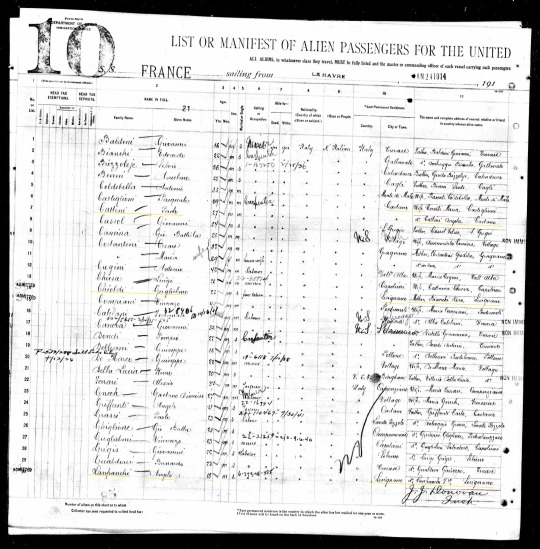
Angelo listed at the bottom of the page. A Paulo Cattani and Gugligemo Chioldi also listed on this page. We'll get to them in a later post.
The following page shows he was en route to Avonmore, Pennsylvania, a small town with a nearby railroad and a population of about 1,200 people as noted in the 1910 and 1920 censuses for the borough, situated in Westmoreland County. This record also claimed his birthplace as Lesignano, while also noting that a 27-year-old married man named Paulo Cattani traveling to the house of his brother, Valentino, in the town (Box 844), with his wife Angela still living in Italy, and a 22-year-old single farm laborer named Gugligemo Chioldi, leaving his mother Rosa Branchi in Lesignano, where Angelo has last lived before leaving the country, but to no specific address.

Says he is going to Avonmore, the same place that Gugliemo Chioldi, and varied others are going.
But why there? It is relatively far out of the way, about 34 miles away from Pittsburgh, not near any major center of commerce now or in the past. The reason is obvious: his siblings were already living there! His married sister Barbara traveled with her husband, John Cattani and their child Genevieve "Jean" back in 1912. They also left from Le Havre, France, and traveled on the S.S. Rochambeau.

John's brother, another Cattani, lived in Avonmore at the time, so it only made sense for them to travel there. But, that wouldn't be the only reason of course, as they likely had other family connections, something which later posts will expand upon.

That's not all! Angelina came to Avonmore two years after Angelo and went to live with Barbara. This record names their father (and my great-grandfather) as Francesco LanFranchi, despite the passenger manifest of Angelo (noted earlier in this post) which called their father "Guiseppe LanFranchi." This also lists her birthplace as Casola, which more aligned with what I have heard about Angelo.

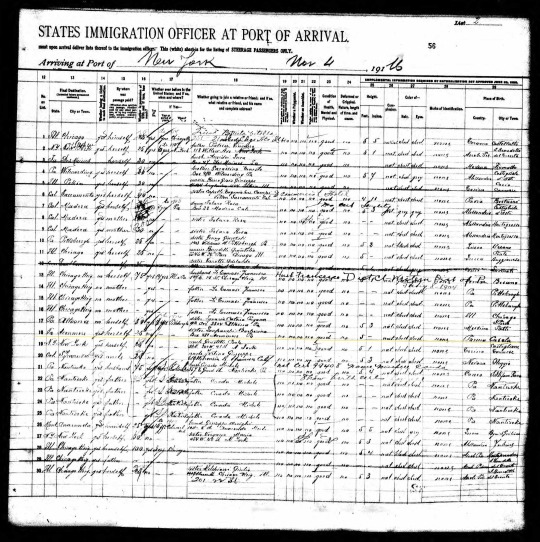
Angelina goes to her sister's home
That brings us to the one million dollar question: why did Angelo immigrate to the U.S.? This is an important question because 1914 was at the tale end of the wave of immigration in the early 20th century to U.S. shores, most coming from Southern Europe and Eastern Europe, with Italians, by the 1930s, as the largest group, in terms of immigrants, in the nation as a whole, in various states, including New York, Louisiana, New Jersey and Nevada. During this immigration movement to the United States, roughly from 1890 to 1919, 18.2 million came to the U.S., 62% from South/East Europe, 26% from North/West Europe, 3% from Latin America, and 2% from South/East Asia.
One theory I heard from some relatives and I considered myself, is that Angelo ran away from Italy due to the draft and that he would be arrested if he went back to Italy. As the story goes, he couldn't even attend the funeral of his mother Adelaide due to fear he would be jailed as a result. Just to be clear, the draft in Italy wasn't like the still-existing "Selective Service System" in the U.S. Some have argued that Italy wouldn't have existed without conscription, a part of wider social and political reforms, and introduced onto the peninsula by none other than Napoleon! In recent years, some Italian politicians wanted to bring it back, claiming there were "threats" which necessitated it! As Marcia Melnyk writes in Family Tree magazine, you can get conscription papers on an Italian ancestor, with the records called registro di leva and listing all "males by year of birth within each military district," with the records often indexed.
History is Now Magazine notes that Italy, generally a new nation-state, only becoming a united country in the 19th century, had an economy mainly based in agriculture but lacked a "competent military." However, the magazine adds that those who wanted Italy to not enter the war (neutralisti) and those who did want want to enter the war (interventisti) clashed with each other, in the political arena. The latter group won when Italy ceased to be part of an alliance with Austria-Hungary and Germany, joining France, Britain, and Russia, declaring war on Germany and Austria-Hungary on May 24, 1915. This meant that Italy didn't enter the war until that point. At the same time, the size of the Italian Army increased from 300,000 in 1915 to five million by the end of the war in November 1918. A strong anti-Austria-Hungry sentiment likely spread across the country since Austria-Hungary was "Italy’s historical enemy." The country's armed forces only expanded due to...conscription, which Italy relied upon since its creation in 1861, in an attempt to supposedly "forge a sense of nationhood." The Italian the army forces used it to acquire personnel until the abolition of conscription in peacetime in 2006, phasing it out after 2000.
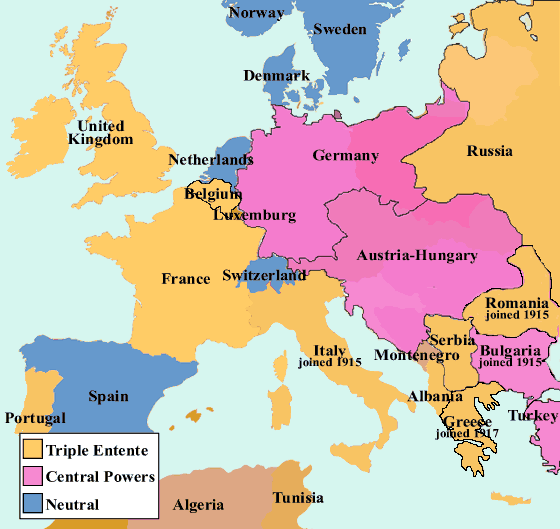
Europe in 1914, via The National Archives (UK)
Of course, there are records of such recruitment, since the Italian government introduced military conscription in 1907. Alexander Watson of the British Library writes that 55% of male Italians aged 18 to 50 were called to military service from 1914 to 1918, while another says conscription of those over age 18 began in 1865. Due to the Pope's message and high death rate, peasants in Italy, apparently, shunned the war, refusing to abide by conscription orders or enlist. This wouldn't be a surprise since Italy decided to base their army after 1870 on unfree labor. Even in August 1914, General Luigi Cadorna, chief of staff of the Italian Army, expected war and began building up the Italian army, concentrating military forces on the country's borders with Austria-Hungary. A few months later, in June 1914, widespread strikes (including a two-day general strike) and rioting rocked the Italian provinces of Emilia-Romagna and Marche, with seizing of railway stations, cutting telephone wires, and burning tax registers, the so-called "Red Week," with the former being the province where Angelo was living.
Furthermore, this description from Mary Tedesco, a professional genealogist who co-authored a book titled Tracing Your Italian Ancestors, gives some tips on tracing your Italian genealogy, points to military conscription records as one of the sources of genealogical information:
Following Italian unification in 1861, military service was required by each Italian male. These records are classified by city or town of birth and year of birth, and in many Italian areas date back to birth years 1840 – 1842. Historical draft records and military service records can typically be found at either the Archivio di Stato [Italian State Archives] in the province where you ancestor lived.
At first, I thought draft records for the Province of Parma didn't survive since a listing of Italian military records lists none for the province, abbreviated as "Reggio Emilia" within the Italian State Archives. However, the State Archives of Parma holds a series titled "Leva Militare" meaning "military draft" [2] which has a 209-page collection from the Ufficio di leva di Parma, otherwise known as the Parma Draft office, the series lasting from 1883 to 1915! This would be a much better resource than trying to page through the hard-to-navigate census (there are only ones for 1861, 1871 and 1881) for Reggio Emilia, which I have basically given up in trying to search through on my computer. I WILL pursue that in the days to come.
War Resisters International claims that draft evasion under existing Italian law is "punishable by up to five years' imprisonment, and five to 15 years' in wartime," relying in a 1991 report on "Conscientious objection to military service" by Amnesty International. However, when translating article 336 of the Italian penal code, known as Codice penale [3], into English, it only clearly only refers to anyone who uses violence or a threat of violence against a public official or someone "in charge of a public service." It has nothing to do with draft-dodging, which is illegal under U.S. law. At the same time, it wasn't until 1972 that the Italian Parliament approved a law which made conscientious objection to the draft by those with "profound religious or philosophical or moral beliefs" legal. Even so, those who were approved to be conscientious objectors still had to perform an eight-month term of "unarmed military service, or civil replacement service" in its place. If someone refused that, then they could be imprisoned for 2-4 years. I'm pretty sure that this provision is no longer valid since conscription fully ended in 2006 for the country as a whole.
How in the world does this relate to Angelo? In order to determine that, some background needs to be established. Italy has established three criminal procedure codes since its creation: one in 1865, another in 1913, one in 1930, and a final one in 1988. Furthermore, the current constitution of Italy wasn't enacted until 1948, and the current civil code, also known as Codice civile, began in 1942. This replaced the one in 1865, an Italian translation of the Code Napoleon, the French Civil Code established in 1804. [4] I am also aware that the Albertine Statute, also known as Statuto Albertino, established by the ruler of Sardinia in 1848, soon became the constitution of the Kingdom of Italy, remaining in force until 1948. This is despite the fact that the fascist rule of Benito Mussolini after 1925 mostly voided its text. The Albertine Statute mentioned the draft in Article 75, stating "the military conscriptions shall be regulated by law." In doing some digging around, I found that article 11 of the Italian Civil Code of 1865 stated that those who received citizenship of a foreign country lose their Italian citizenship. Luckily for all Italian immigrants, a 1912 law revised this. The latter asserted that if someone naturalized after July 1, 1912, all their children "retained Italian citizenship even if they were unemancipated minors as long as they were granted the same foreign country’s citizenship automatically when they were born in that country." As such, Angelo was unaffected by this change.
There is only one mention of "leva" or military service in the 1865 Italian Civil Code: clause 6 of Book 1, Title I (Of Citizenship and Enjoyment of Civil Rights), which focuses on citizenship. That section is shown below:
The son born in a foreign country from a father who lost citizenship before his birth is considered a foreigner.
However, he may elect the status of citizen, provided that he declares it in accordance with the preceding article and establishes his home in the kingdom within the year from the declaration made.
However, if he has accepted public employment in the kingdom, or has served or serves in the national army on land or sea, or otherwise satisfied with military service without invoking an exemption for the quality of foreigner, he will certainly be considered a citizen.
Without a need to examine the previous maritime penal code of Italy or the 1865 procedural code, I looked at the 1869 Codice penale per l'esercito del regno d'Italia, otherwise known as the Criminal code for the Army of the Kingdom of Italy. One provision, article 277, noted how soldiers who forces conditions on others will be excluded from the military for five years. However, a later version of the same document, in 1869, indicates, in Appendix I, Title I, clause 1 that the military will recruit people voluntarily and through the draft, sometimes translated as "military lever." The next title focuses entirely on the draft, with the first chapter outlining those subject to it. I expected the parts about how there is an obligation to contribute to the draft, with certain distributions and determinations, or that all citizens of Italy are subject to the draft, only men in certain draft categories, called upon in "extraordinary contingencies." Even so, clause 7 was the most chilling of all. It stated that citizens subject to the draft cannot "obtain a foreign passport if he does not obtain authorization under the precautions determined by the Regulation mentioned in article 1." A footnote explained this further:
The naturalization abroad, without the prior consent of the Government of the King, does not exempt the citizen from the obligation to draft, whose enrollment must follow only the list of the municipality of the last domicile in the State.
This would mean that if Angelo was naturalized in the U.S. after he immigrated, but had been put on a draft list, then he could NOT return to Italy as he would be arrested for a crime of avoiding the draft, commonly called "draft-dodging." He, like all young men those in Italy from age 16 to 19, would have also needed a written statement known as a nulla osta to legally emigrate. However to get this document would would need to fulfill your military obligations and then you could get a passport. Under Italian law, you could be exempted from "reporting a vital necessity of emigration" if you had brothers or relatives who would engage in "permanent service to the Italian Army."
Further clauses (9, 10, and 11) explained how the King of Italy would determine the distribution of the draft quota, with each province subdivided, and having drawings of citizens for the draft itself. However, as noted in second section of this law's chapter, exact draft operations would be overseen by the Minister of War, seemingly appointed by the King, coupled with various draft boards and commissioners, the latter appointed by the King, to enforce the draft itself. Clause 19 of the law's second chapter noted that men when they turn age 19 (I'll come back to that later on in this post) need to be registered with the draft. The following clause said young people are considered as residents of a certain municipality if their father, father, or guardian lives there, those born in the municipality itself, those from another country who been naturalized in that municipality, and so on. Clauses 22, 23, and 24 were intriguing as they pointed out that the draft list was originally compiled in January by the town mayor:
The Leva [draft/service] list is compiled for the care of the Mayor within the same month of January on the declarations referred to in art. 19, and investigations to be made in the civil status records, as well depending on other documents and information. The first of the following month of February, and for fifteen days consecutive, the list of young people inscribed on that list is published by the Mayor...During the same month of February the Mayor must record all the observations, declarations, or reminders that are made to him for omissions, for false indications, or for errors whatever they may be. The Delegated Council examines the list of Leva [draft/service], and if it is necessary to rectify it in regard to young people who in any way are omitted or unduly registered; and taking into account the observations, declarations and recalls, referred to in article 23 above, it follows the modifications, additions and cancellations that are necessary.
Lets go back to the passenger manifest for the S.S. France. It notes that the ship left Le Havre on January 24, 1914 and arrived in New York on January 30, a six day journey. Angelo's birthday was on September 6. When he left for the U.S. he wasn't 18 years old, yet. He was 17 years, 4 months, and 18 days old, when he left Italy, and six-days older when going through Ellis Island, having lived on the planet Earth for 6,354 days, to take from a handy dandy age calculator. Angelo would turn 18 later that year. I looked back at clause 19, to refresh my memory:
On the 1st of January of each year the Mayors are obliged to make known by express notification to young people who in the beginning of the nineteenth year of their age, the duty to be registered on the Leva [draft/service] list of the Municipality in which they have legal domicile, and their parents or guardians. Obligation that they are required to take care of their registration.
For Angelo, he would not be notified by the mayor of Casola he was being drafted until January 1, 1915, taking this law literally. As such, under this law, he wouldn't be eligible for the draft at the time he left Italy because he wasn't old enough. Later clauses (28 and 29) talk about those who "escaped" draft registration, and note there is a crime for those who escaped the draft, while also noting how the draft will be conducted (see clauses 34-43), specifically this crime is for those that aided and abetted those on draft lists, a punishment of prison and a fine of two thousand lire (see clause 169). This punishment applies to draft dodgers per the previous clause, clause 168. However, if the age Italians was drafted was lowered to age 18, as some sources indicate, then that means that he would have been notified on January 1, 1914!
What I found so far makes me skeptical that avoiding the draft was his reason for immigrating to the U.S. One source contradicts the age I found in the Italian Criminal Code: FamilySearch. The page on Italian military records states that all Italian males since the creation of the Italian state have been "subject to military duty," and stating that the draft of young men began at age 18, a compilation of lists into the liste di leva. [5] These records categorized individuals by year of birth, providing the name of the young men, their parents, place of birth, where they were living, and other relevant data. This is followed by the Liste d'Estrazione (also known as liste di arruolamento), with age 21 males examined by the draft board, looking at the physical, mental, and legal eligibility of men. Again, the men's name, parents' names, place of residence, and other information is listed. In 1923, the preparation of the liste di leva ended, replaced by only the estrazione. Here is where Angelo would have gotten in trouble, without a doubt
Young men had no right to emigrate from Italy before the age of 18 unless the whole family had departed. From the list of all males eligible for the draft, a certain amount of young men were called (extracted) to actually serve the draft. This depended on eligibility and the number necessary to fulfill the draft quota of the Italian State. Therefore, the liste d'estrazioni set forth the names of those draft-eligible men who were actually drafted or exempted. If a young man did not present himself for the draft and was not represented at the draft call he could be declared eligible and labelled as a deserter or accounted for because of an exemption. This happened at times to those who legally emigrated to North or South America and also to those who illegally emigrated and who did not return because they could be imprisioned [sic] for draft evasion.
Other Italian military records include the Registro dei Folgi Matricolari (draftee curriculum of service record), Foglio di Congedo Illimitato (discharge records), and Registro di Ruolo (service records). These would all be part of a "treasure trove of information" than some Italian genealogists have written about. This makes it likely that the law that stated that those age 19 and older would be added to the draft role was changed, especially since terms one would be conscripted into military service declined from five years in 1863 to two years in 1910. [6] Not only in September 1915, when those born in 1896 where called into service, 12.1% did not appear for draft calls, despite a decline in emigration, but to escape extreme misery in the country's agricultural sectors, Italian men (mostly) left the country in huge numbers, about 6.5 million in total from 1905 to 1914, equivalent to 1/6 of Italy's population! Almost 60% went to the U.S., while those that remained, like the peasants (contadini) undoubtedly continued to reject conscription despite the Italian state trying to impose it. [7]
What FamilySearch says puts some credibility to the story he would have fled Italy to avoid the draft. As Jerry Finzi, a semi-retired photographer writes on Grand Voyage to Italy, many Italian men wanted to leave Italy to escape military conscription, although many others wanted only to America, "earn money and return to buy their own land." Avoiding the draft was not uncommon, as thousands did so, either by dodging it, revolting or deserting, when it was introduced during Napoleonic rule over Northern Italy from 1802 to 1814, even though such an effort was said to be "successful," despite the cost that Italians had to bear in Napoleon's imperial designs, coupled with heavy taxation. If FamilySearch has their date wrong, which doesn't seem likely at this point, perhaps Angelo was a planner and realized he would be drafted ultimately and wanted to leave as a result. After all, there were a good number of people who had the surname of LanFranchi who died in Italy in WWI, as noted when you search this Italian genealogical website. I may need to go to a Family History Library to continue this quest to get records or directly request them from Parma. [8] In any case, Angelo had family in the U.S., including his sister Barbara, and joined by his sister Angelina, all concentrated in Avonmore. Even so, there were intricacies in Berte which pulled Angelo away from Avonmore, which created a fascinating set of circumstances...
© 2020-2023 Burkely Hermann. All rights reserved.
Notes
[1] This is noted by his 1929 Declaration of Intention, his WWII draft card in 1942, Al Franci's notes on his father, and his birth certificate issued in 1959. Some other documents say he was born on September 7, specifically his 1915 Declaration of Intention, his WWI Draft Card in 1918 and the marriage application with Jennie Baccarini in 1931. Some information in this post relies on information from one of living cousins, who also mentioned a number of other people like Ralph Nastari.
[2] Leva means either lever, draft, conscription, and so on. After all, the term "servizio di leva" means "national service," referring to the draft. I have used it to be draft or service here, just in case there are any translation errors.
[3] As noted by one legal site, Italian criminal is codified into the Codice Penale (Criminal Code) and Codice di Procedura Penale (Code of Criminal Procedure) and is divided generally into three books: “Crimes in general”, “Types of Crimes”, and “Types of Misdemeanors”.
[4] One site remarks that "the civil code of 1865 seemed to be the perfect goal of li-beral politicians, who wanted to strenghten State’s unity through legislative unity. The State Library of Louisiana adds that in 1865, the newly-formed Kingdom of Italy created "its own new Codice Civile, which retains and reflects much of the original Napoléonic Code."
[5] The age of 18 as the beginning year for those drafted has also been asserted by David A. Fryxell in Family Tree, ItalyGenWeb, My Italian Family, By 1927, the age the draft began was also age 18. In A Handbook of Military Conscription and Composition the World Over, Rita J. Simon and Mohamed Alaa Abdel-Moneim write, on page 85, that "after a 200-year old practice of conscription since the Napoleonic time in Italy, where all males aged 18 to 26 had to perform military service for 10 months, the Italian Senate voted overwhelmingly in 2000 to abolish conscription...conscription can still be reactivated in times of war or national crises."
[6] John Gooch, The Italian Army and the First World War (US: Cambridge University Press, 2014), 8-9.
[7] Ibid, 135, 214-215.
[8] There are four collections which I'd look at: "Liste di leva della provincia di Parma 1913-1914"; "Liste di leva della provincia di Parma 1914"; "Liste di leva della provincia di Parma 1914-1915"; "Liste di leva della provincia di Parma 1915". It says that to access these images you need to access the site at a family history center or at a FamilySearch affiliate library. If anyone could help with this, that would be great.
#louis franci#angelo lanfranchi#lanfranchi#franci#francis#lanfranchis#immigration#immigrants#italians#italian genealogy#genealogy#family history#ancestry#repost#wordpress#ettory bertolo#bertolo#avonmore#pennsylvania#barre vermont#vermont#cattani#passenger ships#ships#photographs#le havre#uk national archives#chioldi#cattanis#chioldis
0 notes
Text
Spirits | 52 Ancestors
Spirits are an alcoholic product made from fermented sugar. The fermented sugar is distilled to yield a higher alcohol by volume. During World War II, sugar was a black market commodity needed for illegal distilling operations.
On 28 April 1945, Robert Guice was charged with illegally distilling spirits. Following is his record of incarceration in the state of Alabama.
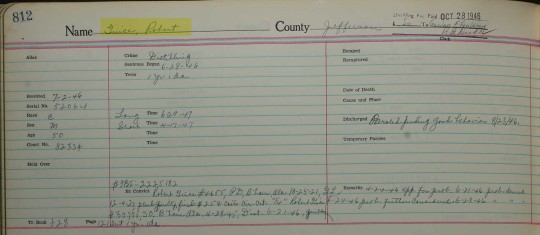
The record shows that an application for parole made on 24 April 1946 was denied. Robert Guice was found guilty on 21 June 1946, and sentenced to serve one year and one day. As of 24 June 1946 probation was given further consideration, but denied on 28 June 1946. It appears that Robert had a prior conviction in 1921. The record notes he pleaded guilty and was fined $25 and circuit court costs.
Robert was fifty years old when he entered confinement on 2 July 1946. He was paroled pending good behavior on 23 August 1946. A notation was made that the distilling fee was paid on 28 October 1946.[1]
Robert Guice, the son of Chapel and Laura Ann (Harris) Guice, was born on 3 June 1895 in Mount Andrew, Barbour County, Alabama.[2] He moved to Birmingham, Alabama around 1917. Robert married Minnie Lee Driver on 5 June 1918 in Birmingham, Jefferson County, Alabama.[3] Shortly after his marriage, Robert joined the U.S. Army. He served during World War I from August to November 1918.[4] During his lifetime, Robert worked as a cook in a restaurant,[5] a laborer in a box factory,[6] and a machinist for the St. Louis-San Francisco Railway (the “Frisco”).[7] At the time of the 1950 U.S. Census, Robert was listed as “unable to work”.[8] However he was the owner/operator of Guice Grocery in the 1950s.[9] Robert died on 13 July 1970 in Birmingham.[10]
Sources
“Alabama, U.S., Convict Records, 1886-1952,” database with images, Ancestry (https://www.ancestry.com : accessed 3 July 2020) > State Convict Records > Volume 24: 19444-1946> image 817 of 1004, Robert Guice, serial no. 52064; citing Alabama Department of Corrections and Institutions (1939–1953). State Convict Records, 1889–1952. Alabama Department of Archives and History, Montgomery, Alabama.
"United States World War I Draft Registration Cards, 1917-1918," database and images, FamilySearch (https://www.familysearch.org/ark:/61903/3:1:33SQ-GYR5-SPGB : accessed 3 April 2013) 5146808 > image 1158 of 4575, Robert Guice, serial no. 347, order no. 120, Draft Board 7, Birmingham, Jefferson County, Alabama; citing NARA microfilm publication M1509.
Jefferson County, Alabama, Marriage Record Colored, vol. 75: 573, Robert Guice and Minnie Lee Driver, 5 June 1918, minister's return by Rev. F. W. Riley; imaged as "Alabama County Marriages, 1809-1950,” FamilySearch (https://www.familysearch.org/ark:/61903/3:1:3QS7-89HV-89TX-M : accessed 10 June 2017) 7316776 > image 143 of 821; citing Jefferson County, Alabama Judge of Probate.
Compiled service record, Robert Guice, serial no. 4754849; World War I; digital images, "Alabama, World War I Service Cards, 1918-1919," FamilySearch (https://www.familysearch.org/ark:/61903/3:1:3Q9M-CSTC-MS2V-P : accessed 7 April 2023).
1920 U.S. census, Jefferson County, Alabama, population schedule, Birmingham, Enumeration District (ED) 56, sheet 8-B, dwelling 154, family 172, Robert B. Guice; imaged at FamilySearch (https://www.familysearch.org/ark:/61903/3:1:33S7-9R6W-2 : accessed 2 November 2023) 4964206 > image 359 of 1091; citing National Archives microfilm publication T625, roll 24.
1930 U.S. Census, Jefferson County, Alabama, population schedule, Birmingham, Enumeration District (ED) 37-1, sheet 1-A, page 1 (stamped), dwelling 4, family 4, Robert Guice; imaged at Ancestry (https://www.ancestry.com : accessed 2 November 2023) >Alabama > Jefferson > Birmingham > District 0001 > image 1 of 41; citing National Archives microfilm publication T626.
1940 U.S. census, Jefferson, Alabama, population schedule, Birmingham, enumeration district (ED) 68-1, sheet 1A, household 6, Robert Guice household; digital images, FamilySearch (https://www.familysearch.org/ark:/61903/3:1:3QS7-89MT-99B8 : accessed 14 February 2023) 5454783 > image 5 of 918; citing National Archives and Records Administration microfilm T627, roll 91.
1950 U.S. census, Jefferson County, Alabama, population schedule, Birmingham, Enumeration District 68-1, sheet 12, dwelling 121, Robert Guice household; imaged at National Archives (https://1950census.archives.gov : accessed 3 April 2022).
Polk’s Birmingham (Jefferson County, Ala.) City Directory 1957 (Richmond: R. L. Polk & Co., 1957), 406, entry for “Guice Robt B (Minnie L; Guice Grocery)”; imaged in “U.S., City Directories, 1822-1995,” Ancestry (https://www.ancestry.com : accessed 6 October 2018) > Alabama > Birmingham > 1957 > Birmingham, Alabama, City Directory, 1957 >image 361 of 985.
Compiled military service record, Robert Guice, serial no. 4754849, World War I.
0 notes
Video
vimeo
Balanescu Quartet - The Model (Kraftwerk Cover) from Costanza Tarabella on Vimeo.
Balanescu Quartet - The Model (Kraftwerk Cover) from the 1992 release album Possessed is the copyrighted property of its owner(s).
Homage to Eadweard Muybridge.
No copyright infringement intended.
From Wikipedia, the free encyclopedia
Eadweard Muybridge (/ˌɛdwərd ˈmaɪbrɪdʒ/; 9 April 1830 – 8 May 1904, born Edward James Muggeridge) was an English photographer known for his pioneering work in photographic studies of motion, and early work in motion-picture projection. He adopted the first name "Eadweard" as the original Anglo-Saxon form of "Edward", and the surname "Muybridge", believing it to be similarly archaic.[1]
Born in Kingston upon Thames, England, at the age of 20 he emigrated to the United States as a bookseller, first to New York City, then to San Francisco. In 1860, he planned a return trip to Europe, but suffered serious head injuries en route in a stagecoach crash in Texas.[2][3] He spent the next few years recuperating in Kingston upon Thames, where he took up professional photography, learned the wet-plate collodion process, and secured at least two British patents for his inventions.[2] He returned to San Francisco in 1867, a man with a markedly changed personality. In 1868, he exhibited large photographs of Yosemite Valley, and began selling popular stereographs of his work.
In 1874, Muybridge shot and killed Major Harry Larkyns, his wife's lover, but was acquitted, in a controversial jury trial, on the grounds of justifiable homicide.[4] In 1875, he travelled for more than a year in Central America on a photographic expedition.
Today, Muybridge is best known for his pioneering chronophotography of animal locomotion between 1878 and 1886, which used multiple cameras to capture the different positions in a stride; and for his zoopraxiscope, a device for projecting painted motion pictures from glass discs that predated the flexible perforated film strip used in cinematography.[5] From 1883 to 1886, he entered a very productive period at the University of Pennsylvania in Philadelphia, producing over 100,000 images of animals and humans in motion, occasionally capturing what the human eye could not distinguish as separate moments in time.
In his later years, Muybridge gave many public lectures and demonstrations of his photography and early motion picture sequences, travelling frequently in England and Europe to publicise his work in cities such as London and Paris.[6] He also edited and published compilations of his work (some of which are still in print today), which greatly influenced visual artists and the developing fields of scientific and industrial photography. He retired to his native England permanently in 1894. In 1904, the year of his death, the Kingston Museum opened in his hometown, and continues to house a substantial collection of his works in a dedicated gallery.
0 notes
Text

I posted 379 times in 2022
22 posts created (6%)
357 posts reblogged (94%)
Blogs I reblogged the most:
@gentlyepigrams
@sharkselfies
@paramaline
@deeisace
@hickeywiththegoodhair
I tagged 312 of my posts in 2022
Only 18% of my posts had no tags
#the terror amc - 37 posts
#nautical and fascinating - 17 posts
#where's the lie - 15 posts
#fan art - 9 posts
#art - 8 posts
#polar exploration - 7 posts
#history - 7 posts
#severance - 7 posts
#harry goodsir - 6 posts
#fandom - 6 posts
Longest Tag: 112 characters
#despite the possibility of recency bias much of the new series has gone in one side of my head and out the other
My Top Posts in 2022:
#5

Well this warms my frozen little heart. That's an award that means more than a dozen Emmys.
14 notes - Posted November 17, 2022
#4
Me: GenX goth girl who picked up her first issue of Sandman back in 1989 and has read the series through more times than she can count.
My spouse: has never read the comics and has only the vaguest idea of what it's about.
We're three episodes into the Netflix series and I am telling you, I have not had this much fun with reader vs. never-read since the first season of Game of Thrones.
"There are jokes? I wasn't expecting ... whimsical humor."
"When he gets his stuff back and his powers back, does he actually, like ... do shit, and not just mope around?"
"... It's blowing my mind to hear Jenna Coleman swearing."
21 notes - Posted August 10, 2022
#3
Despite months of upheaval and being dubbed a "vile deviant" for writing kissy fanfic, I did it: my fic for this year's @theterrorbigbang, Something Rich and Strange.
Harry Goodsir's life, imagined as a garden of forking paths. It's 1848 and he is dying in a tent on King William Island. It's 1849 and he is having yet another tiresome argument with the administration of Surgeons' Hall over funding for the museum while he waits for his friend Edward Forbes to return from the Arctic. It's 1854 and he's serving in the Crimea with James Fitzjames. It's 1861 and he is collecting butterflies under the watchful eyes of asylum orderlies. It's 1870 and he is walking on the beach near Fife with his children. It's 1886 and Silna holds his hand as he breathes his last. All of these things are true.
Featuring:
The stunning art of @elfgrandfather !

Ruminations on mortality, fate, paths not taken, and what could have been!
A sequel/prequel/spinoff to last year's story and another installment in my growing AU!
An excessive commentary post!
All the things you have come to know and love about my Terror writing!
Enjoy!
24 notes - Posted August 28, 2022
#2
Penguin Fitzpenguin has a new pal, Armfish Fitzarmfish.

DeadGhostCrafting is doing God's work here. All his armfish are delightful, but obviously I had to go with this one.
55 notes - Posted April 14, 2022
My #1 post of 2022
Good morning, fellow aficionados of terrible medical history. Would you like an interactive text game about pre-germ theory, pre-anaesthesia surgery? Well, you're in luck.
268 notes - Posted June 30, 2022
Get your Tumblr 2022 Year in Review →
0 notes
Text
American Oz | Article: The Wizard in the White City
L. Frank Baum’s long and winding road to Oz, and the Chicago World’s Fair that inspired his life’s work.
— April 6, 2021 | Kirstin Butler

Art by Mawhyah Milton. Source photo of L. Frank Baum: Library of Congress.
L. Frank Baum needed a new life. In February 1886, his brother and business partner Benjamin died of pneumonia. The two Baum brothers had launched their venture, a petroleum byproduct called Baum’s Ever Ready Castorine, from their father’s successful oil refinery. Frank’s heart had never really been in the family business, though, so when his father died in February 1887, Frank resolved to start over.
It wouldn’t be the first time Baum reinvented himself. The 31-year-old was a master of self-transformation, both by choice and out of necessity. The range of occupations he’d already held were enough to fill several biographies: poultry fancier, actor, singer, playwright, producer, now axle grease salesman. None of these ventures, however, had succeeded in providing both fulfillment and food on the table, and he had a growing family with two young sons to support.
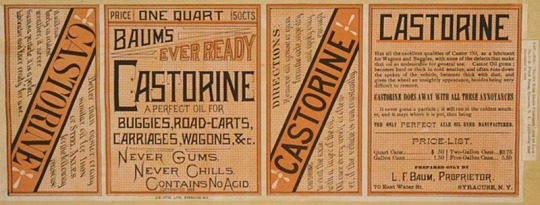
Product label from a patent application for Baum’s Ever Ready Castorine, December 1883. Library of Congress
In 1888, after visiting his wife Maud’s brother in the Dakota territory, Baum moved his own family from Syracuse, New York out west. “In your country,” Baum wrote to his brother-in-law, “there is an opportunity to be somebody.” Land agents pitched Aberdeen, a settlement in what would soon officially become South Dakota, as a city on the rise, a blank slate full of possibility and potential. Casting himself as a self-made man, Baum meant to claim his own piece of the country; no matter that his family was homesteading on land that the Sioux tribes had called home for generations.
But the shimmering city on the prairie proved to be a mirage. Weather in Aberdeen was extreme, and the economy followed its vicissitudes. Long, hard winters followed on long, hot summers, and every rung of society, from banking to farming, felt the effects of those conditions. When they arrived in the Dakotas, Baum made a quixotic attempt at opening a business, a shop called Baum’s Bazaar that sold luxury items and whimsical toys and ornaments. Then a harsh drought in 1889 brought financial ruin to many in the area. No one sought whimsy, and Baum’s turn as a shop proprietor came to a close on New Year’s Day, 1890.
He sank the funds he recouped from a buy-out of the Bazaar into a new enterprise, an existing newspaper that he renamed the Aberdeen Saturday Pioneer. Already by the winter of 1891, though, the Pioneer was a lost cause. The paper’s operations had become unsustainable to the point that Baum was funding it personally. In its decline, the Pioneer was going the way of many businesses in Aberdeen. The frontier town’s prospects had turned out to be far fewer than those promised by the sales pitches that had lured Baum out west, three years earlier. The shuttered newspaper marked the next in what had become a string of failures.
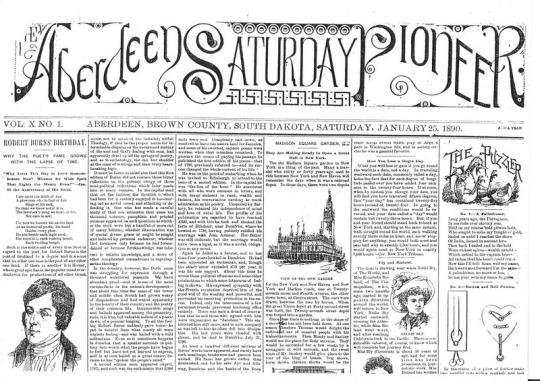
The front page of L. Frank Baum’s Aberdeen Saturday Pioneer for January 25, 1890, two months after South Dakota became a state.
Even as the Pioneer’s fortunes waned, Baum saw signposts pointing to a new future. The wire reports reaching his editor’s desk contained a growing number of stories about the imminent arrival of the World’s Fair in Chicago. Also known as the World's Columbian Exposition, in honor of Columbus’s landing 400 years earlier in the so-called “new world,” the fair was to be the largest individual event in American history. An April 1890 act of Congress declared it would be held in Chicago, which had won out over New York, Washington, D.C. and St. Louis, and the already booming city was poised for even more growth as a result.
Baum made plans to raise stakes. He hoped for yet another fresh start and for his family to leave hardship behind on South Dakota’s dusty plains. On a January 1891 visit to the city, already anticipating the end of his run as a newspaper publisher, he secured a gig at the Chicago Evening Post. Maud waited until May of 1891 to join Baum in the city. She arrived with a newborn, making for four young sons in all. Unfortunately, at $20 a week, that job proved too little to secure the Baum household.
While Baum was still on the Evening Post staff, however, the paper ran a tantalizing story about a wizard: Thomas Edison, the “Wizard of Menlo Park,” known for the astounding creations emerging from his research lab, which was originally located in Menlo Park, New Jersey. Edison was among the country’s leading talents tapped to realize the grand ambitions of the Chicago exposition, and the Evening Post reported on a May 1891 press conference in which the inventor hinted at magic acts he was planning for the exhibition. “Greatly interested in the world’s fair is the wizard,” reported the Post. “It has been stated that the invention which Mr. Edison is to exhibit at the fair as his piѐce de résistance is something that will surpass in its surprises anything that ever came from his wonderful workshop.”
Another two years would pass before the World’s Fair formally opened. Still, the city was abuzz with news of its progress. Public interest was so great that even as the fairgrounds were being built, thousands of people per week paid to visit them under construction. Meanwhile, Baum, still struggling to stay afloat, took a sales job at a wholesale crockery firm.

An artist’s rendering of the Chicago World’s Fair, located along the city’s Lake Michigan waterfront, 1893. Library of Congress
When the great fair finally opened on May 1, 1893, Baum joined the quarter million attendees gawking at the vision within its gates. The White City consisted of 14 brilliantly white neoclassical structures. This Court of Honor, as it was called, was arrayed around the Great Basin, an artificial lake more than eight football fields large, and populated with a collection of birds that Baum, the former poultry breeder, must have appreciated. Yet the alabaster structures were a grand illusion: steel skeletons sheathed in a mixture of jute, glycerin and painted plaster of Paris. When Baum first laid eyes on the White City, it’s possible its outer layers were still wet. At night, the buildings shone just as bright—more lights illuminated the fairgrounds than there were lighting all of Chicago. Seven years later, audiences would read about another glistening city in The Wonderful Wizard of Oz: “[I]f you did not wear spectacles the brightness and the glory of the Emerald City would blind you.”

A bird’s-eye view of the White City. Gondolas ferried fair attendees through the man-made canal system created to traverse it, 1893. Library of Congress
All of that magic was some way off in May 1893. In the coming year, the United States plunged into the deepest depression in its history. Baum witnessed at a national level what he had already lived through in Aberdeen: businesses and banks closing, widespread unemployment and livelihoods lost. After the fair closed, two fires ripped through the White City and took its optimistic vision of the future up in flames.
Yet Baum already had what he needed, not just for another personal reinvention, but for the invention of a new world. With rare artistic alchemy, he transformed all that he’d borne witness to: the flat midwestern plain, an enigmatic wizard, a dazzling metropolis.
At 44 when The Wonderful Wizard of Oz was published in 1900, Baum finally found his way, and along with it an enchanting fairytale that became a new American classic.
“How can I get there?” Oz’s wandering heroine asks the Witch of the North in her long quest to get back home. “You must walk,” comes the response. “It is a long journey, through a country that is sometimes pleasant and sometimes dark and terrible. However, I will use all the magic arts I know of to keep you from harm.”
0 notes